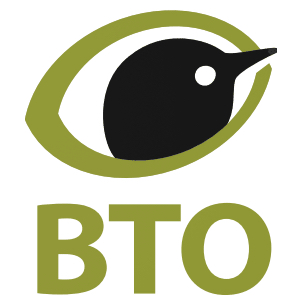So you've spotted or heard a bird in your garden, and would like to work out what it is. Whether you're a beginner birdwatcher, or an advanced one that's refreshing your knowledge, our guide to garden birds will help you identify what you've seen or heard, including how to differentiate between males and females where possible.
We've also included a bit more information about each bird, so you can learn about what food they eat both in the wild and in your garden, or fascinating insights into their behaviour.
In this expert guide, we have covered some of the most common garden birds you're likely to spot, but each garden is different and you may have other avian visitors, such as siskins, redpolls, blackcaps and more.
If you'd like to learn more, discover nine of the best British bird identification books in this article by BBC Countryfile Magazine.
How to attract birds to your garden
An easy way to attract more bird species to your garden is to offer food and shelter. Installing a nestbox (and providing nesting materials) can be invaluable for your garden birds, encouraging them to set up home in your plot.
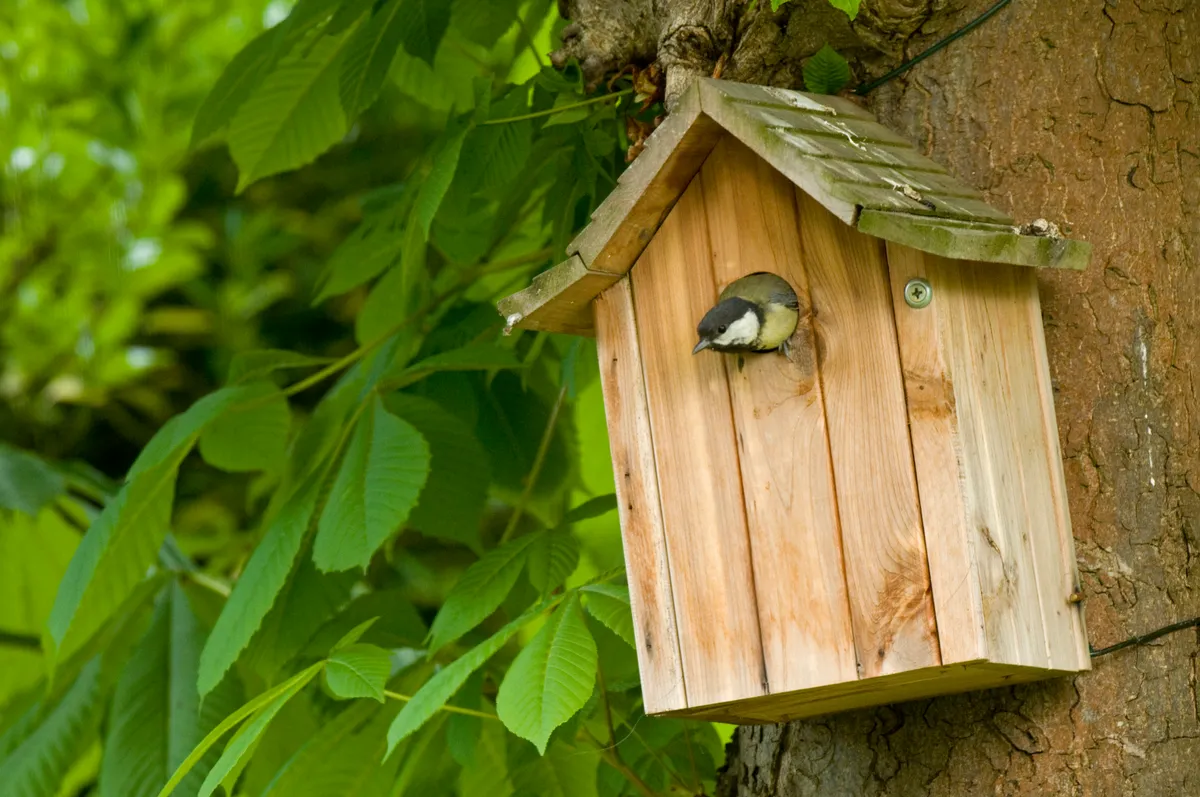
Simple tips such as hanging bird feeders (such as a pine cone feeder, an orange bird feeder, or a fat cake) and providing access to clean drinking water (such as a bird bath or bird splash) can also encourage them to visit when food is scarce. Countryfile.com have a handy garden bird care guide if you'd like more advice.
Our wildlife gardening guides are also a useful source of advice.
How to identify common garden bird species
Common blackbird (Turdus merula)
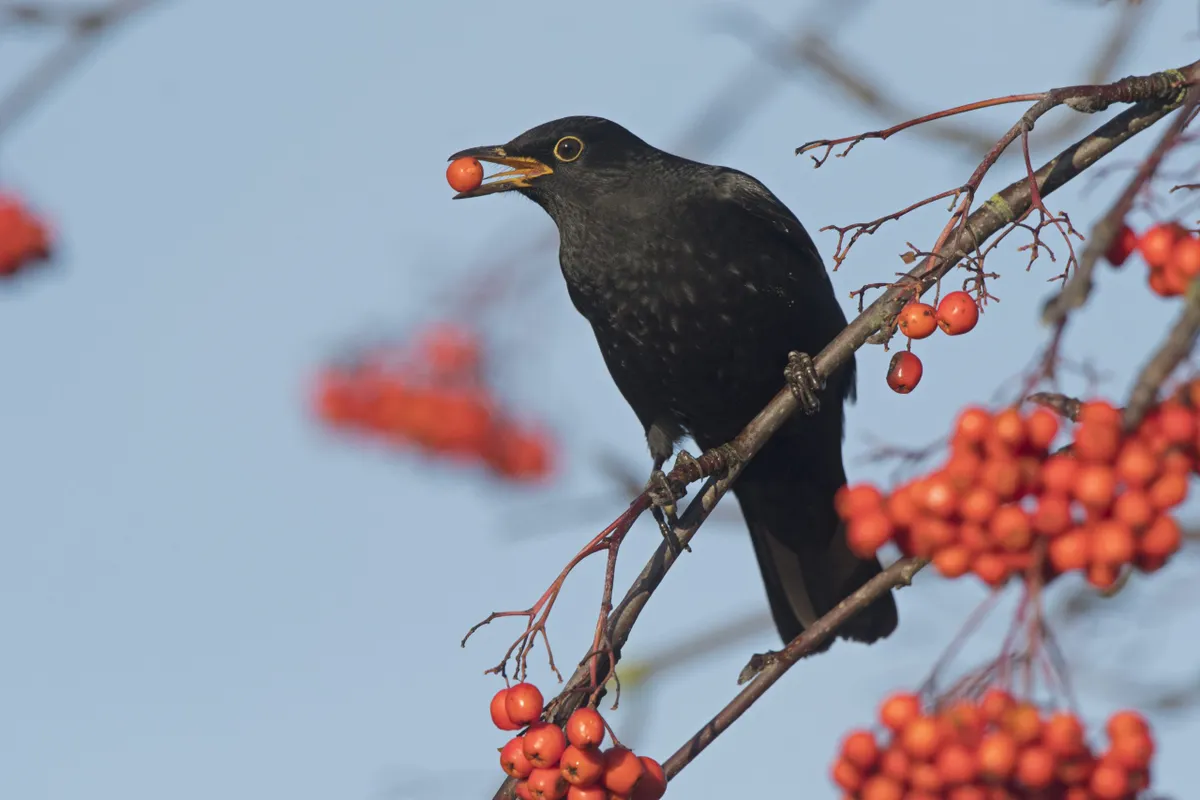
In the UK and British Isles, the common blackbird is usually just to referred to as the blackbird. A familiar bird to many, the blackbird can be found in a variety of habitats, including gardens, and can be easily identified by it's black (male, pictured above) or dark brown (female, pictured below), and yellow eye-ring and bill. Juveniles are a warm brown with spotted plumage.
Blackbirds are found across the UK and are resident all year round. In winter, our resident birds are joined by migrant birds from Fennoscandia (also known as Fenno-Scandinavia, consisting of the Scandinavian and Kola peninsulas, Finland, and Karelia).
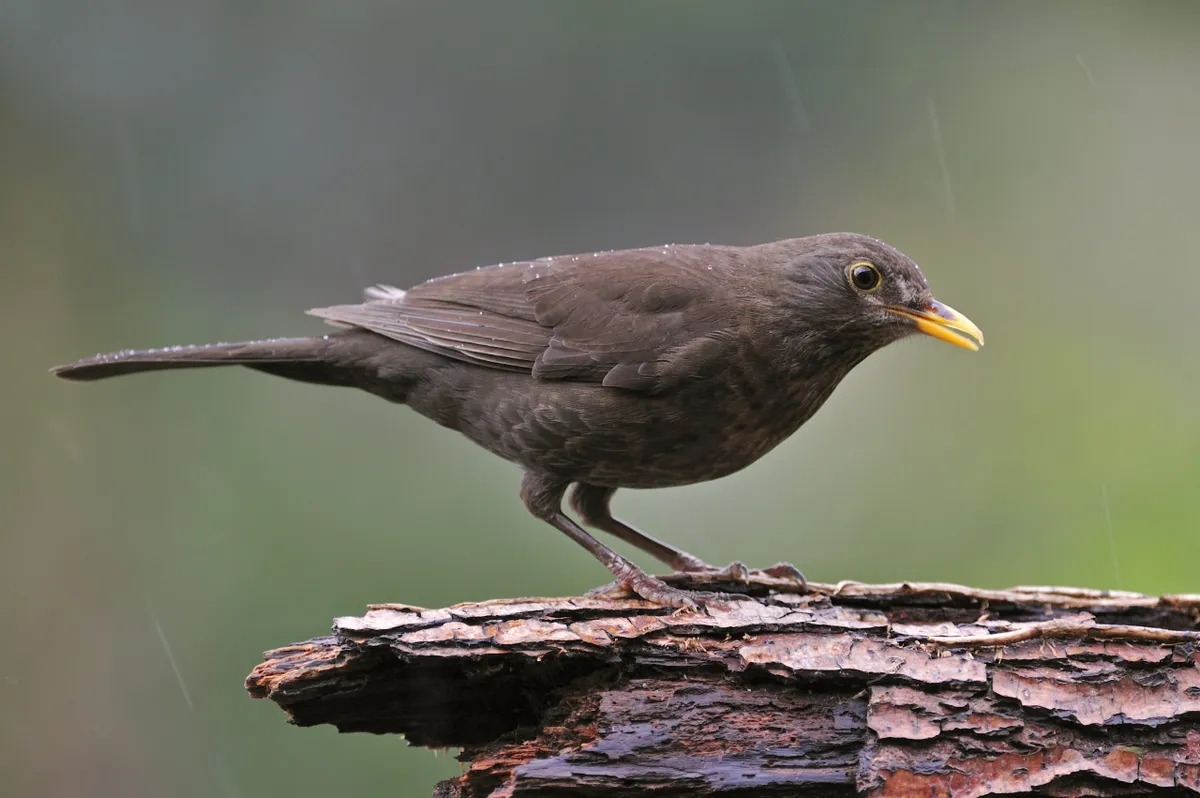
The male’s song is a fluty, melodic whistle. The song is sometimes heard after dark, as birds sing under artificial light. Calls are very loud and involve various clucking and rattling sounds.
Blackbirds belong to a group of birds called the thrushes (all in the Turdus genus), which also includes song and mistle thrushes (both discussed below), redwings, fieldfares, and ring ouzels.
Song thrush (Turdus philomenus)
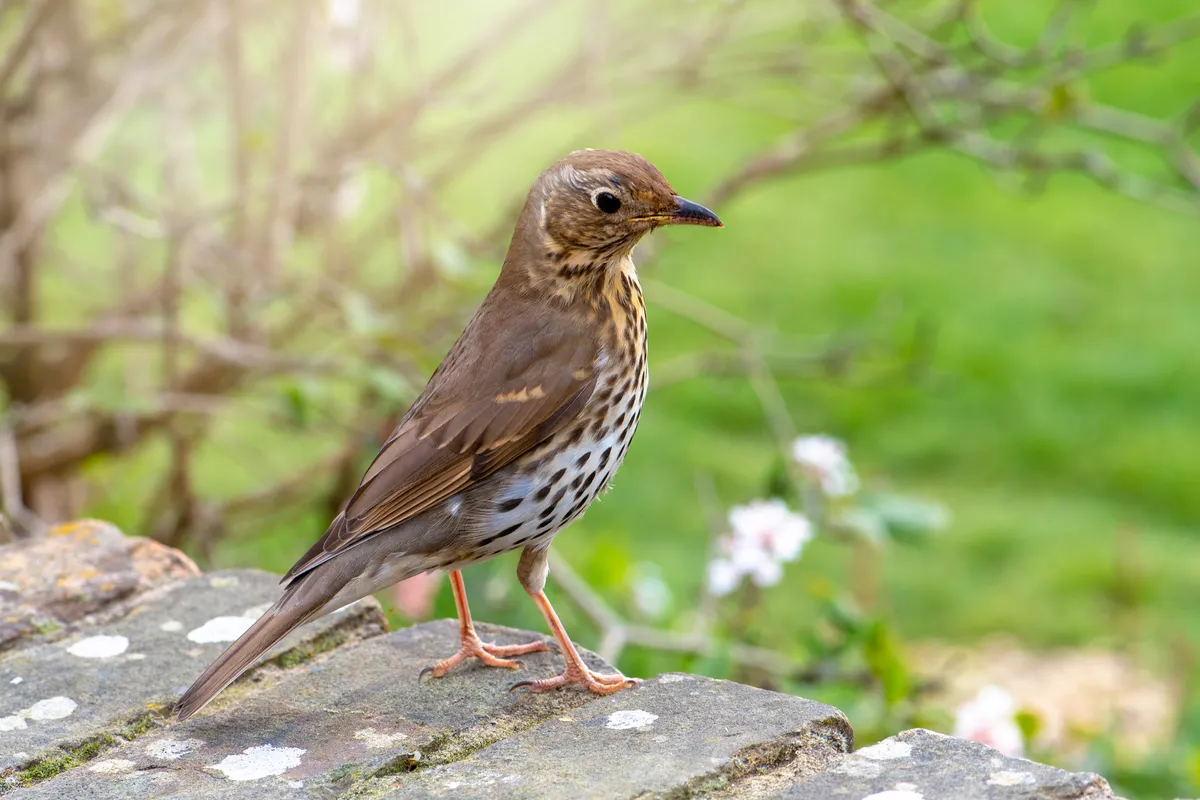
It is very easy to confuse a song thrush and a mistle thrush (below). Song thrushes are smaller and generally have warmer brown tones on their upperparts, whereas the mistle thrush is paler. The key, however, is in the spots. Song thrush spots on their underparts look more like inverted ‘arrowheads’ which are sparsely spread on the breast and flanks..
There are many reasons that people love song thrushes, but its song has made it a well-known part of the countryside. While the song is less rich than that of a blackbird, its bold, bell-like clarity has a penetrating quality. It consists of a series of phrases with many repeated three times in succession, making it a recognisable song.
The song thrush used to be a very common bird in the UK. In fact, in the early 20th century it was more abundant than the blackbird. However, since the 1940s, blackbirds have flourished, making them a more familiar bird these days.
This may be due to the reduced availability of snails and earthworms, particularly in gardens and farmland where pesticides are used. Other causes suggested for the overall decline include changes to farming practices, land drainage and woodland management.
Mistle thrush (Turdus viscivorus)
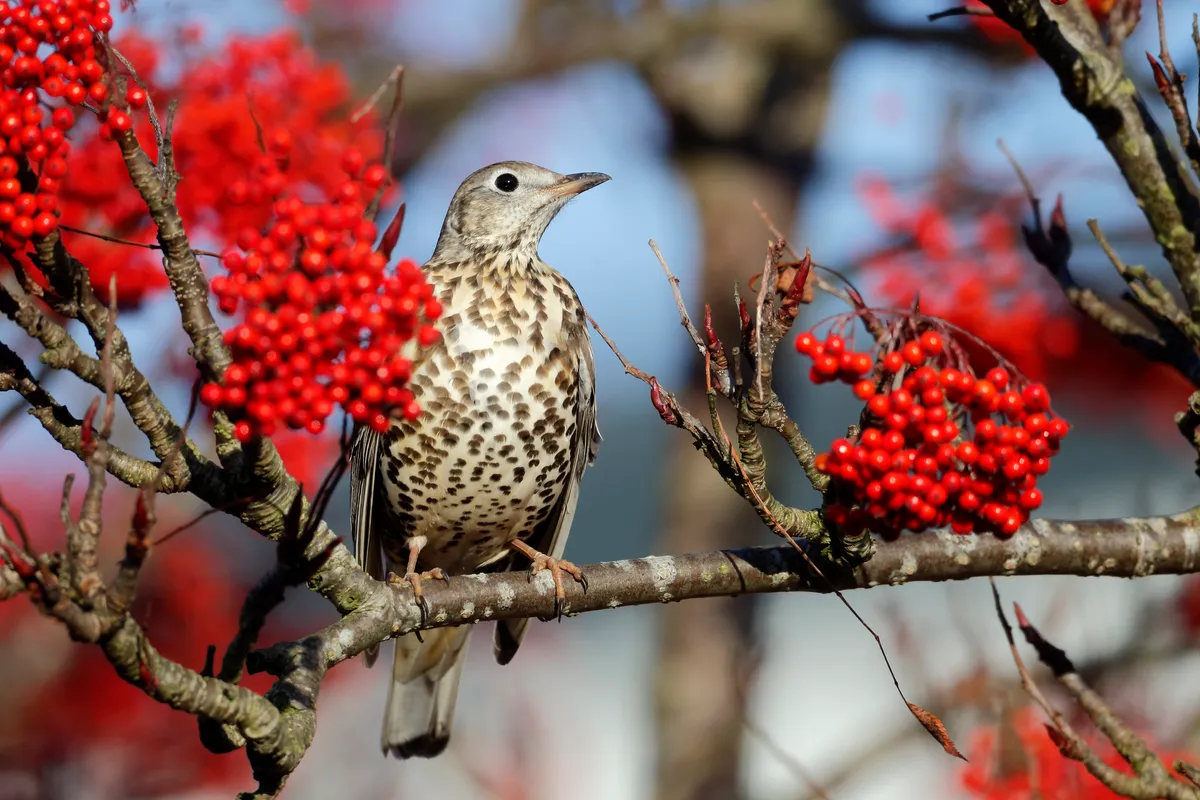
While song thrushes are more common in gardens, mistle thrushes use them too, especially during the autumn and winter. Their diet mostly consists of invertebrates and berries, but they will come into gardens for windfall apples.
Mistle thrushes are noticeably larger than song thrushes, with a longer tail. They have pale grey-brown upperparts, and their white underparts are heavily spotted, with the spots on the belly and flanks more rounded in appearance.
One of the earliest breeders of the year, mistle thrushes will lay eggs as early as the end of February. This doesn’t mean that they stop early though, as each pair rears up to three broods of chicks, and may continue through to the end of June.
Mistle thrushes have a rattling call, particularly when alarmed or disturbed.
Woodpigeon (Columba palumbus)
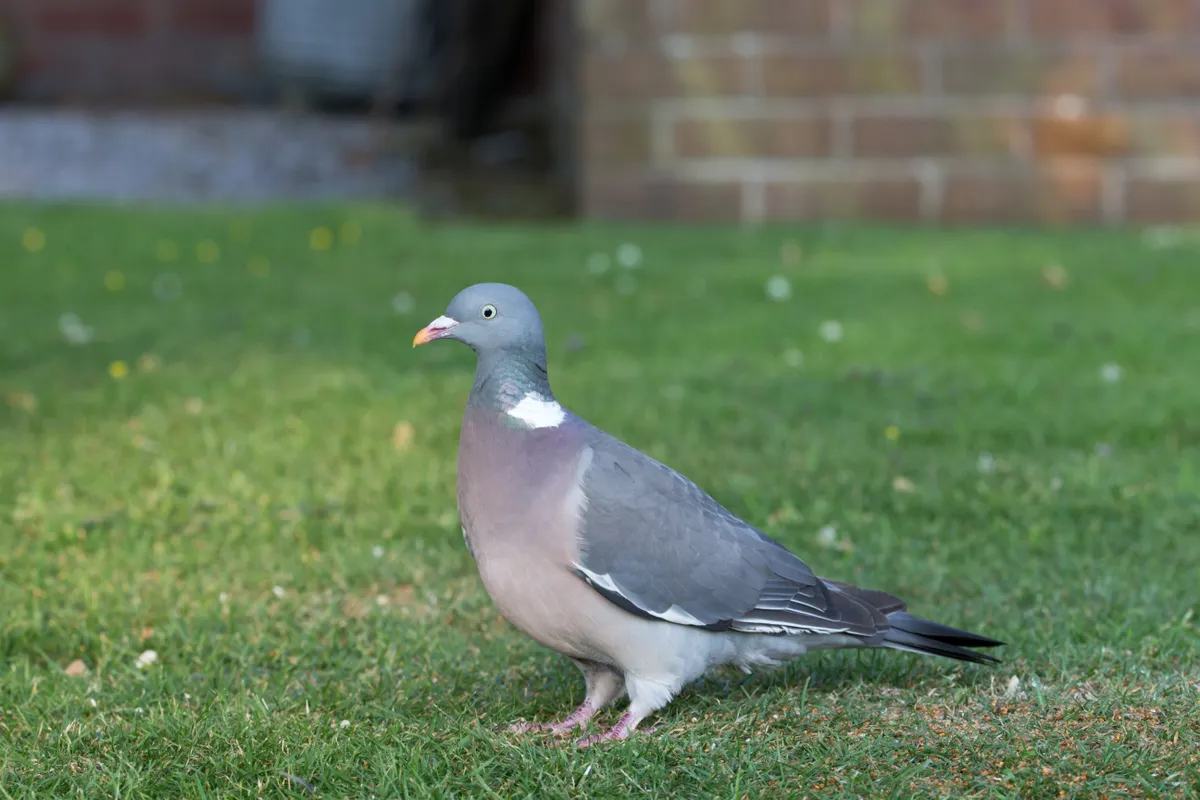
Male and female woodpigeons look alike, and adults can be told from other pigeons by the large white patches on the sides of the neck, below smudge of iridescent green. Juveniles lack the white neck patches.
Woodpigeons eat seeds, leaves and fruit (especially ivy berries), plus buds and various agricultural crops. Woodpigeons are able to take in a lot of food in a sitting because they can store it in a crop, which is a muscular pouch in the upper chest.
The weight of food in a woodpigeon’s crop is often over 70g, and weights of up to 155g have been recorded, including crops containing 725 ivy berries, 758 wheat grains, 30 cherries and 38 acorns. Once all this food has been taken on board the bird has to sit and rest while digestion takes place; this is why woodpigeons spend much time perched and inactive.
Eurasian collared dove (Streptopelia decaocto)
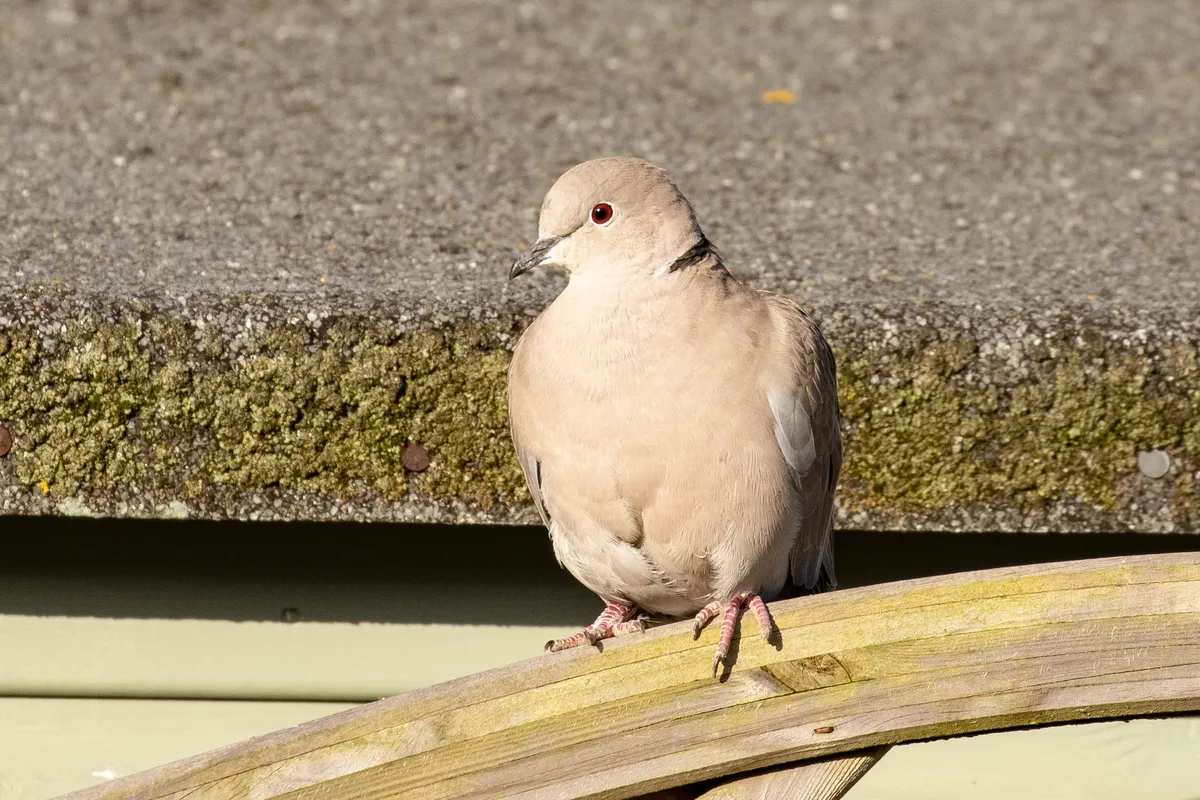
Collared doves are smaller and more delicate-looking than woodpigeons, with creamy grey-buff plumage. Adults have a black half-collar on the back of their necks. Their typical call is a clear and persistent three note ‘coo coo cuk’ which some people think sounds like ‘un-i-ted’.
The Eurasian collared dove bred for the first time in Britain in 1955 in Norfolk. Before 1930 it was confined to Turkey and the Balkans in Europe, although it was found as far east as China. In the next 20 years, it rapidly expanded its range northwest, quickly colonising most of Europe, and now lives north of the Arctic circle in Norway and as far south as Morocco and the Canary Islands.
So collared doves have only lived and bred in the UK for a few decades, but they weren’t introduced – they spread to new areas on their own, as their young have a tendency to disperse far and wide.
One factor behind the collared dove’s success is its ability to breed year-round if the weather is mild. They may also start a new nest before the previous young are independent, with the female using breaks from incubation to feed recently fledged offspring.
European robin (Erithacus rubecula)
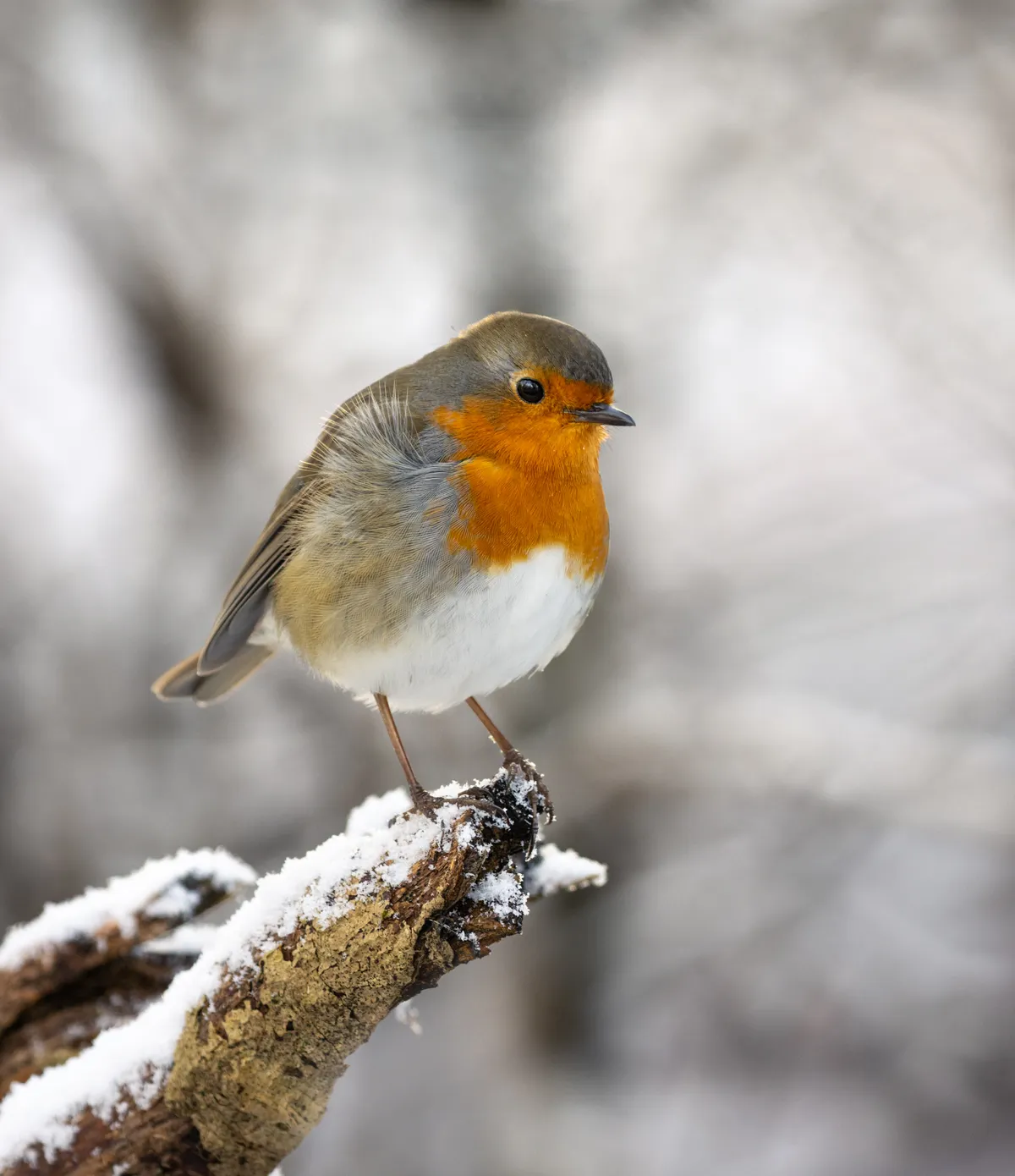
The robin’s red breast is part of what endears it to us, providing a welcome flash of colour on a winter’s day. But its evolutionary purpose is for a more serious role, with male robins using it to settle territorial disputes, especially during the breeding season.
Robins are very territorial birds and will viciously attack other robins that on their patch. A dispute starts with males singing at each other, trying to get a higher perch in order to show off their breast most effectively. This usually ends the challenge, with one individual deferring to the other.
Sometimes it can escalate to a fight, which can result in injury or death.
Robins eat a wide variety of food, including worms, seeds, nuts, suet, invertebrates and fruit. They’ll readily come to garden bird tables, especially in winter, and a combination of suet, mealworms and seeds will go down particularly well.
Dunnock (Prunella modularis)
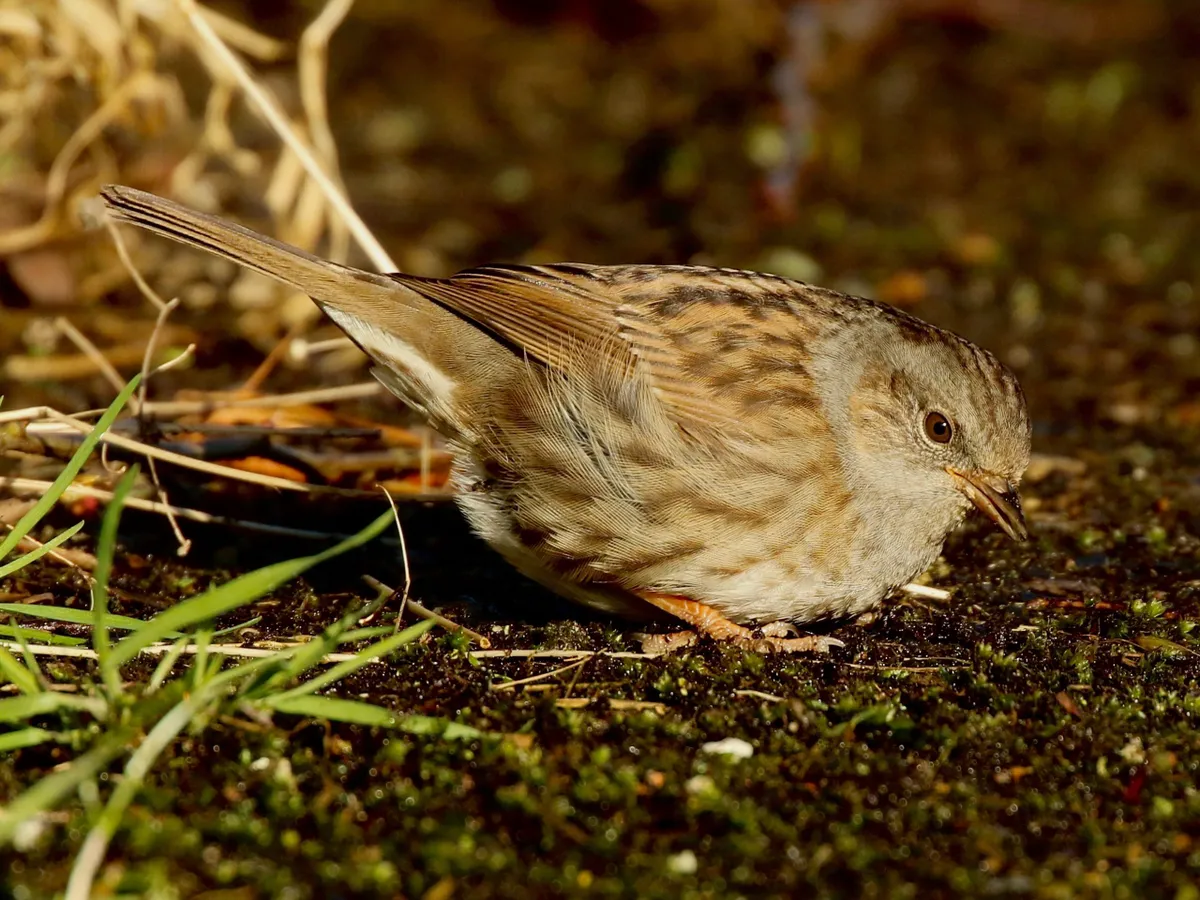
Also known as ‘hedge sparrows’, dunnocks are commonly mistaken for female house sparrows. Dunnocks are streaked black and brown above and below, with a lead-grey head. They have fine, dark bills. Young juvenile dunnocks have pale bills and light speckled feathers, but they soon develop into their adult features.
Dunnock song consists of a series of undistinguished rushed phrases, less melodious than a robin. Their alarm call is a single, flat piping note.
Dunnock nests are often targeted by cuckoos in the countryside. Despite the dunnocks’ bright blue eggs looking quite different from the pale, speckled egg of the cuckoo, it doesn’t seem that dunnocks are capable of ejecting these ‘imposter’ eggs. This suggests that dunnocks are a relatively recent host that hasn’t evolved a response to this act of parasitism.
House sparrow (Passer domesticus)
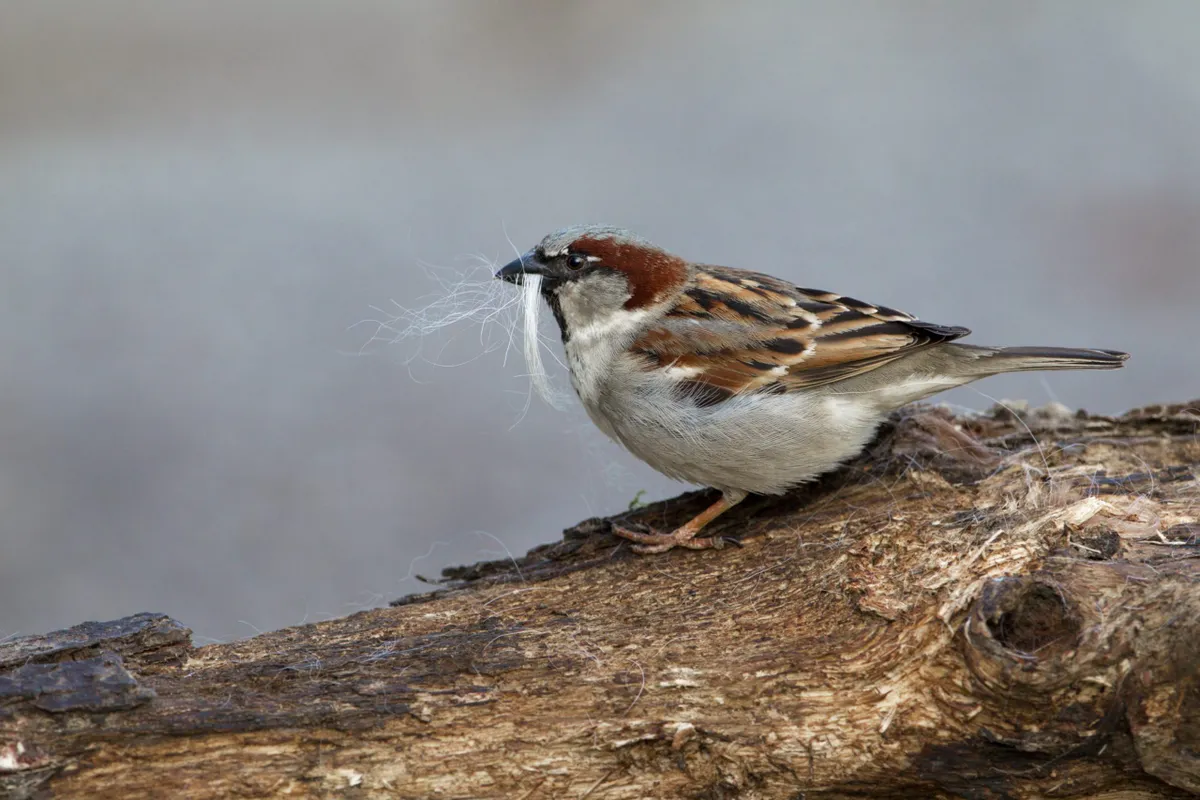
Male house sparrows have a black bib, black face mask and a chestnut brown head with a grey crown. They also have a broad white wing bar.
Female and juvenile house sparrows are dusky brown with greyish-white undersides and dull-brown, but streaked backs. They lack the black bib of the male and have pale brown crowns with a buff line above the eye.
House sparrows mate for life, like many bird species. But they are fairly unusual in that the male and female live in each other’s pockets all year round. This model of stability is echoed in their wider social life.
Each pair lives within a loose colony of, say, 10–20 birds, and all of the pairs and unattached members of the colony know each other well and undertake many of life’s chores – foraging, preening, dust-bathing and roosting – together.
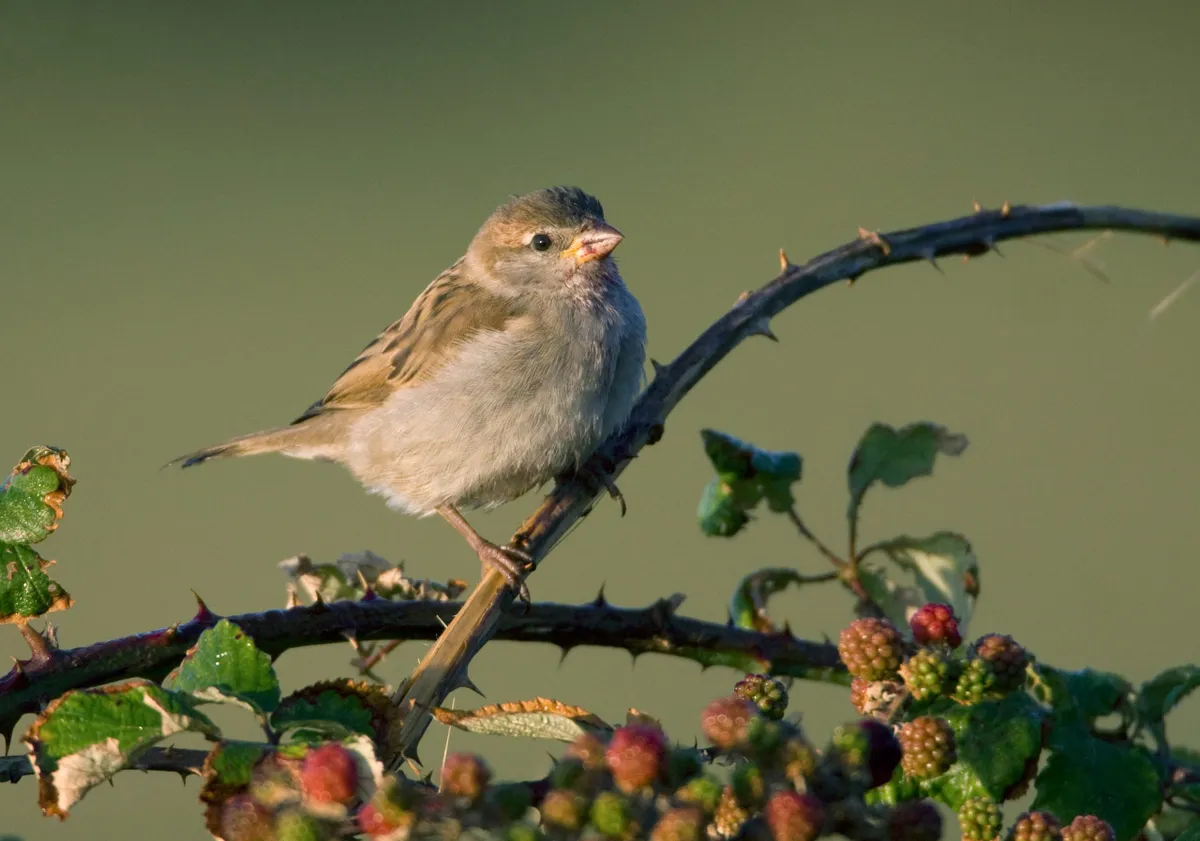
England’s house sparrow population fell by 70% between 1977 and 2016, and have declined in gardens since BTO Garden BirdWatch began. Although reasons behind this decline are not known, the availability of food and nest sites in urban areas is thought to be a significant contributing factor, and one study showed that 74% of the house sparrows tested in London carried avian malaria.
Wren (Troglodytes troglodytes)
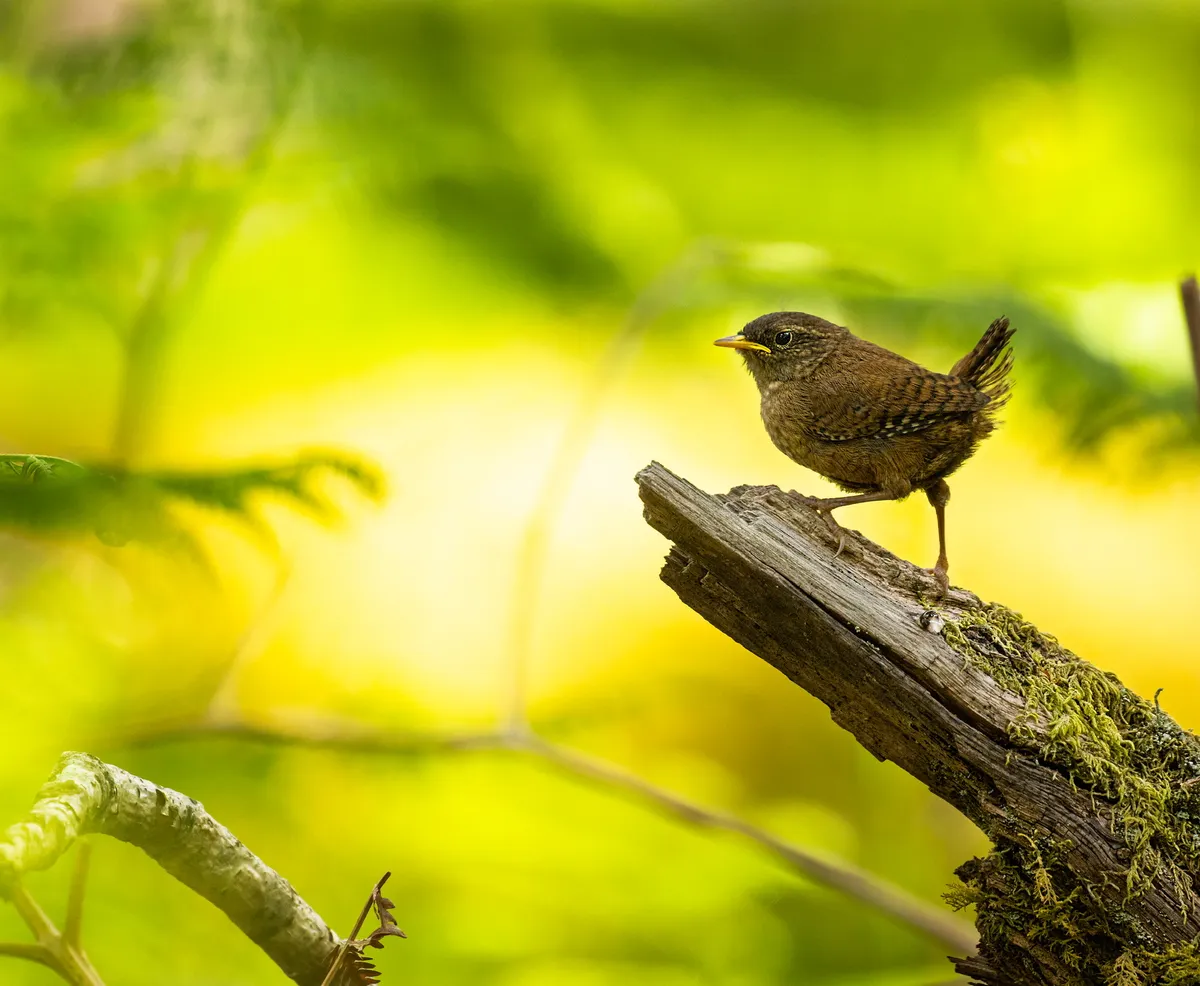
The wren is a familiar but fleeting sight in our gardens, flitting beneath the undergrowth in search of insects, recognisable by its tiny size, brown body and the fact that it often holds its short, stubby tail erect. When seen close, it has a long bill and pale-coloured line above the eye.
While wrens generally don’t use feeding stations, when the weather is particularly severe they will be tempted by high energy foods such as fat cakes. You can also scatter small cake crumbs or cheese around the bases of bushes so that they don’t have to come out from cover to feed.
You’re more likely to hear a wren than see it. They have a surprisingly loud song which is well-structured and consists of a series of clear, but shrill notes. They also have a familiar scolding alarm call consisting of a rapid chittering.
The wren's scientific name, Troglodytes troglodytes, is a tautonym, where the genus and specific name are the same.
Goldcrest (Regulus regulus)
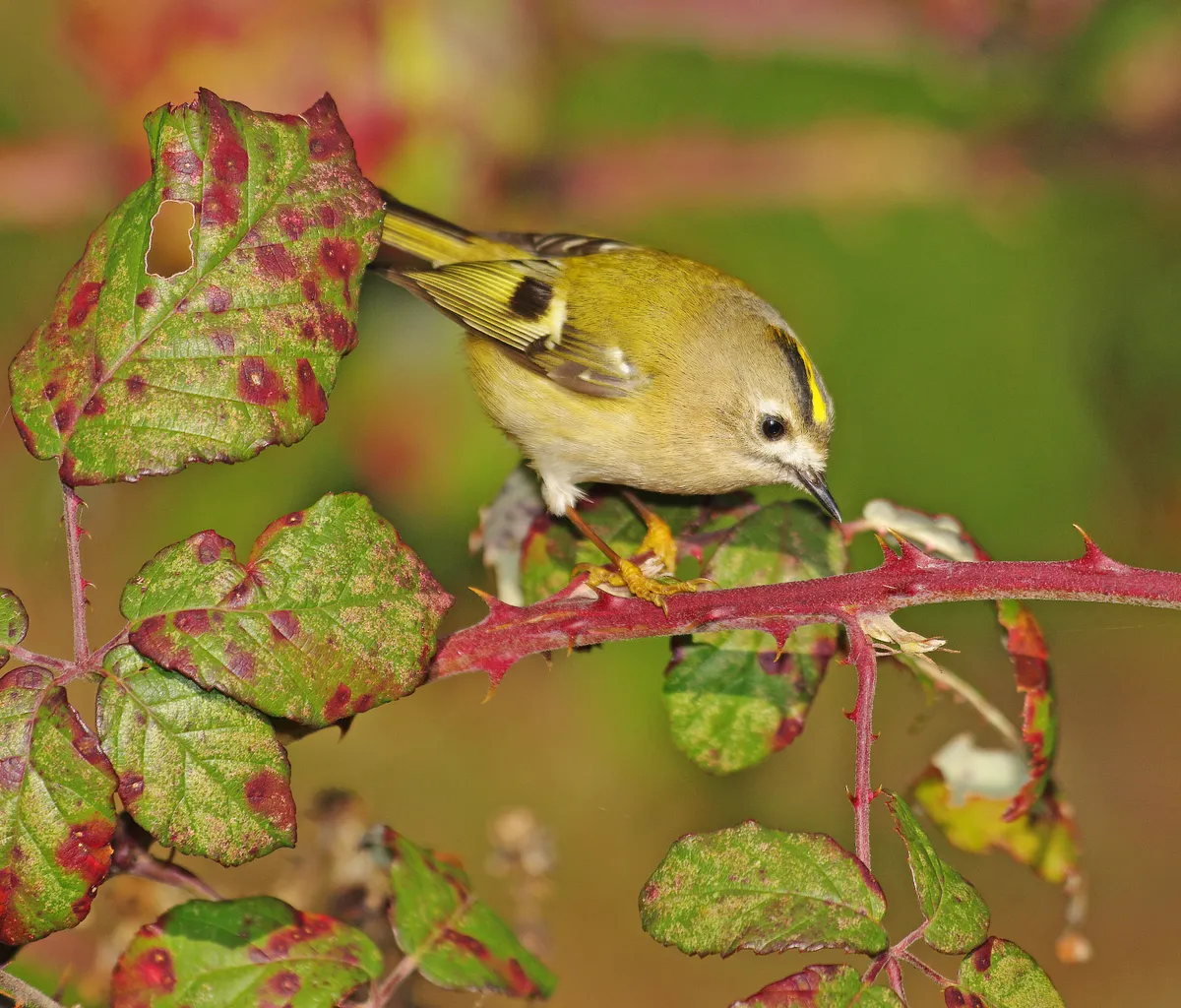
The goldcrest weighs around 5g, about the same as a 5p coin. Associated with coniferous forests, goldcrests are almost entirely insectivorous and make the most of their light weight by foraging in places where larger birds can’t go, like at the very end of small branches. It is similar in appearance to the firecrest, and one of the key differences to look out for is whether there is a black stripe across the eye (present = firecrest, absent = goldcrest).
Given their size, it is hard to believe that some goldcrests migrate to the UK from northern Europe, making them one of the lightest bird species in the world to migrate over the sea.
Your chance of seeing a goldcrest increases during the spring and autumn when migrants are passing through, but goldcrests are found in gardens all year round according to the BTO Garden BirdWatch survey.
However, as they generally ignore our bird feeders, we rarely see them. During winter they need to keep their energy reserves up, so if you’re lucky you might see one feeding on a fat ball.
The goldcrest's scientific name, Regulus regulus, is a tautonym, where the genus and specific name are the same.
Great tit (Parus major)
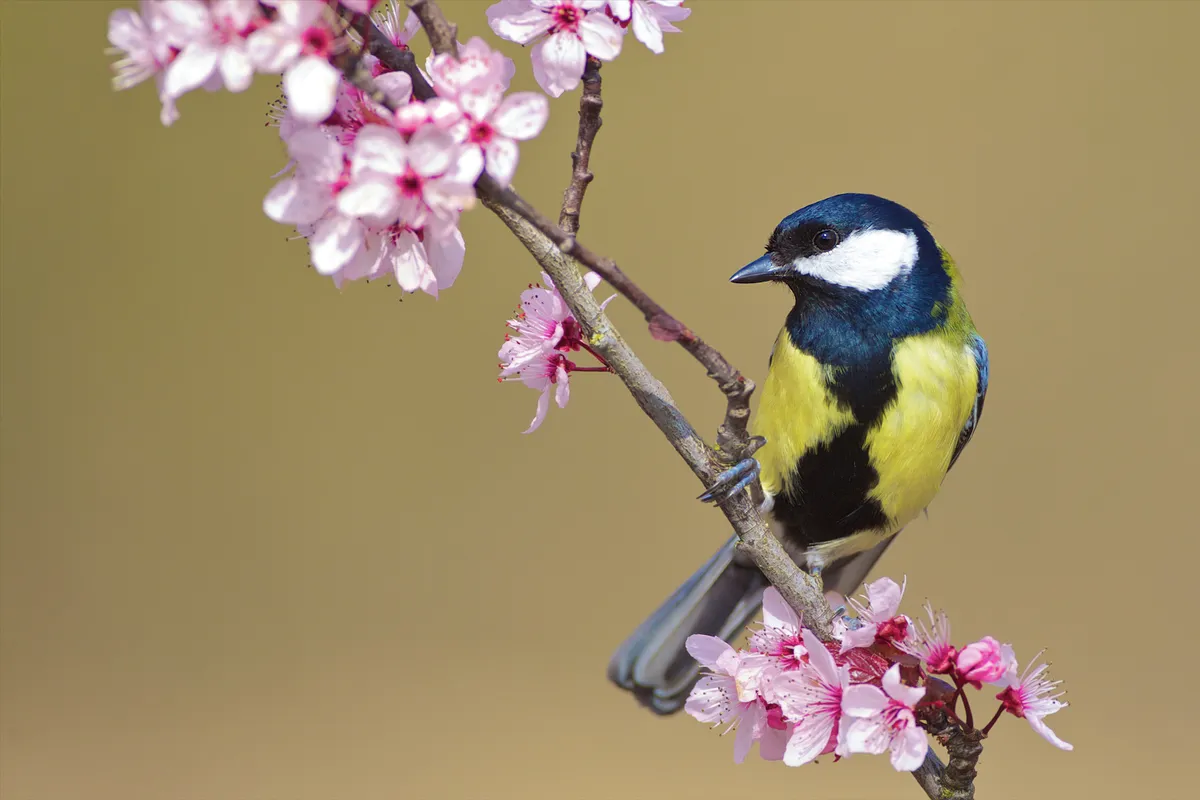
Great tits are easy to identify. They have a black head and chin, white cheeks and a yellow breast.
The key marking to look out is the black stripe running down their front. This is also how you can identify the sex of the bird. The stripe on females narrows and stops halfway down the belly whereas on males it extends between the legs. The bolder and wider the stripe on the male, the more dominant the bird.
Great tits thrive on seeds in the winter, and caterpillars during the breeding season. To help with the change from seed to caterpillar, the shape of great tit bills undergo a subtle change between seasons, becoming more suitable to each food type. When feeding on caterpillars, the bills become longer and less deep and when they start to feed on seeds, the bills become shorter and deeper.
The basic song of a great tit is easy to learn. You’ll hear them singing two notes over and over again saying ‘tea-cher’.
Blue tit (Cyanistes caeruleus)
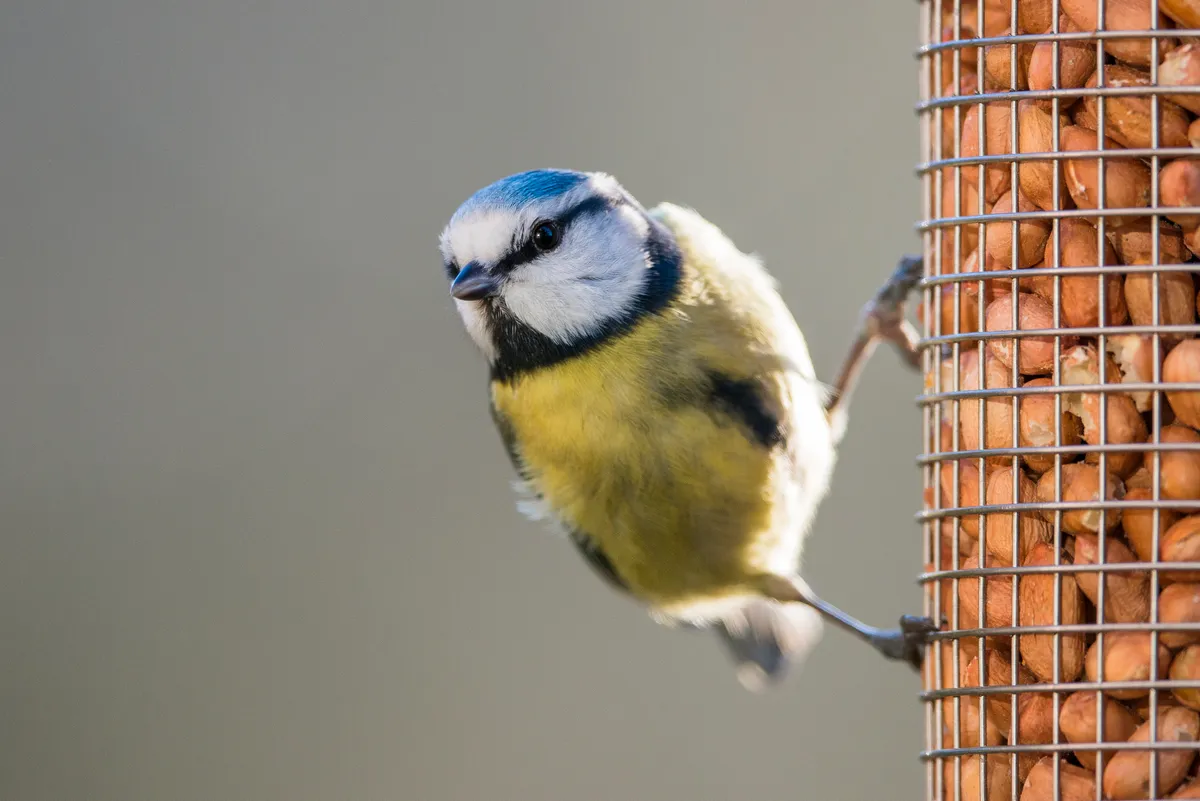
Blue tits have small blue caps with a white head and a black eye-stripe. They also have yellow underparts and a bluish back, becoming brighter blue at the wings. Male and female look similar but juveniles are duller in appearance, with no blue cap or white cheeks.
The song of blue tits is an urgent sounding trill and they have various scolding calls.
Blue tits eat insects and spiders. They will also take fruit and seeds in winter, and they regularly visit garden bird feeders.
Coal tit (Periparus ater)
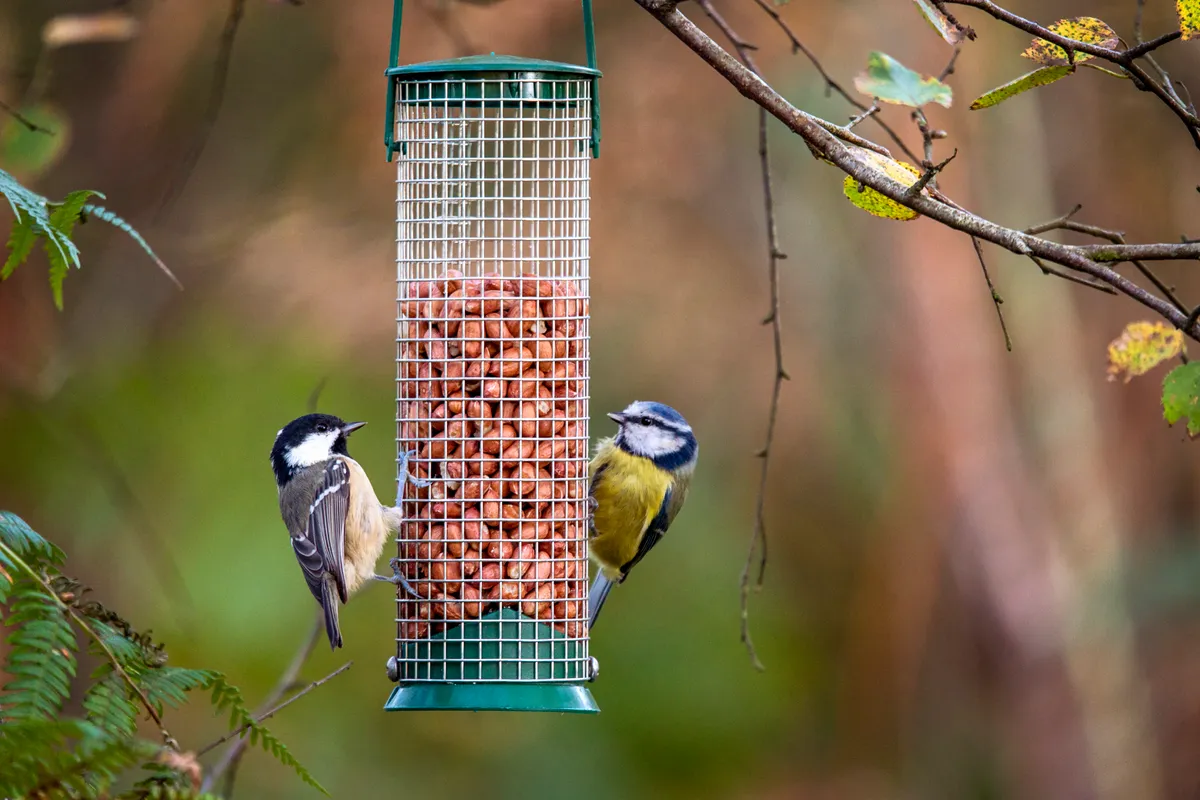
If the only tits that you can confidently identify are blue and great tits, you are not alone. Marsh, willow and coal tits all have similar colouring making them harder to tell apart. But out of the three, the coal tit is the easiest to spot.
It has a larger black bib than the others, giving it obvious white cheeks. If you wait for the bird to turn around, there is one key giveaway – if it has a distinct white stripe running down the back of its head, it is a coal tit.
Due to their small size (they weigh about the same as a fifty pence coin) they struggle to defend feeding perches against bigger, more dominant species. Therefore, they regularly take their food ‘to go’, eating in nearby bushes and shrubs.
Long-tailed tit (Aegithalos caudatus)
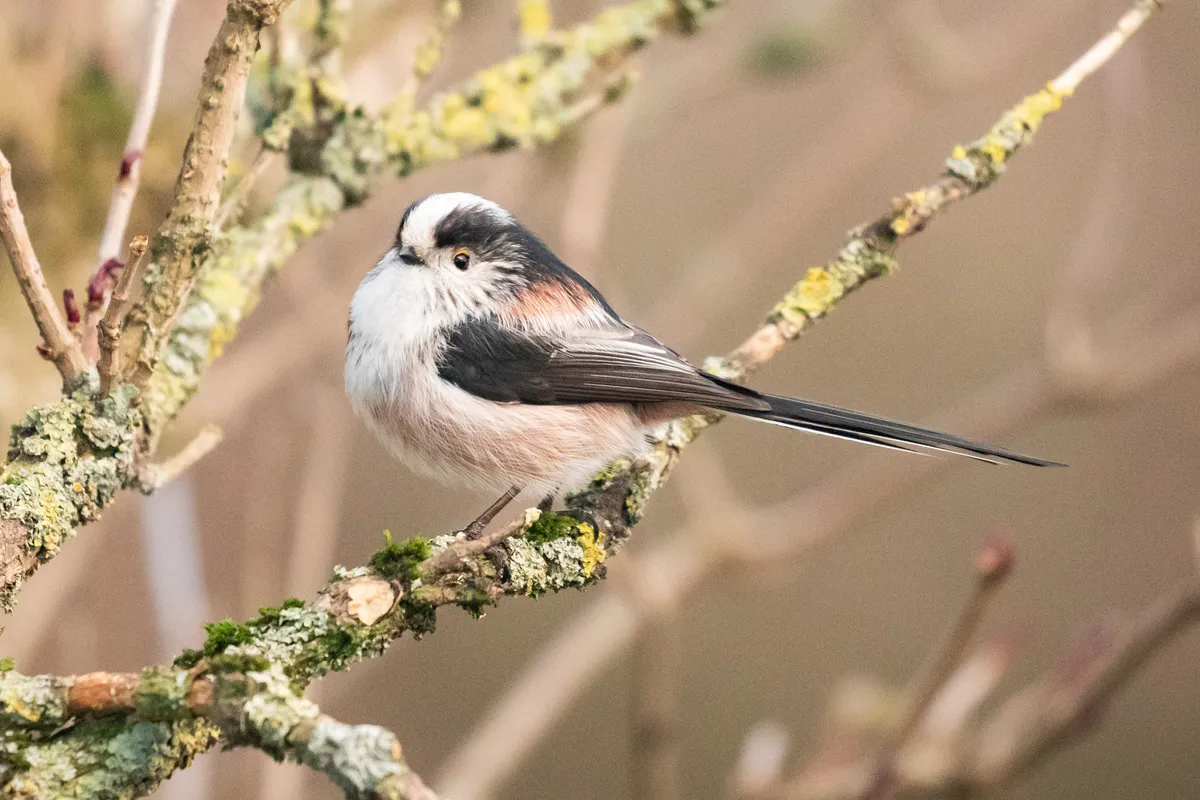
Long-tailed tits are very small, mainly black and white birds, which have almost spherical bodies and an oversized tail. In flight, these proportions give these birds the resemblance of lollipops undulating through the air.
Also, look out for attractive, pinkish markings on the breast and pink eye rings. Both sexes look alike.
Balls of these tumbling, see-sawing birds bounce from one garden to the next during winter, their high-pitched, rolling si-si-si-si-si calls, punctuated with more percussive, clipped notes, announcing their arrival.
These vocalisations help flock members, which tend to be close relatives, keep in touch with each other as they move restlessly through trees and bushes, gleaning invertebrates and dropping down onto garden feeders.
The small beak of the long-tailed tit is not proficient at handling large seeds. However, this species will swarm over suet-based products, which provide a quick calorific hit. Small seeds, bread crumbs, finely grated cheese and peanut fragments will also be taken.
Nuthatch (Sitta europaea)
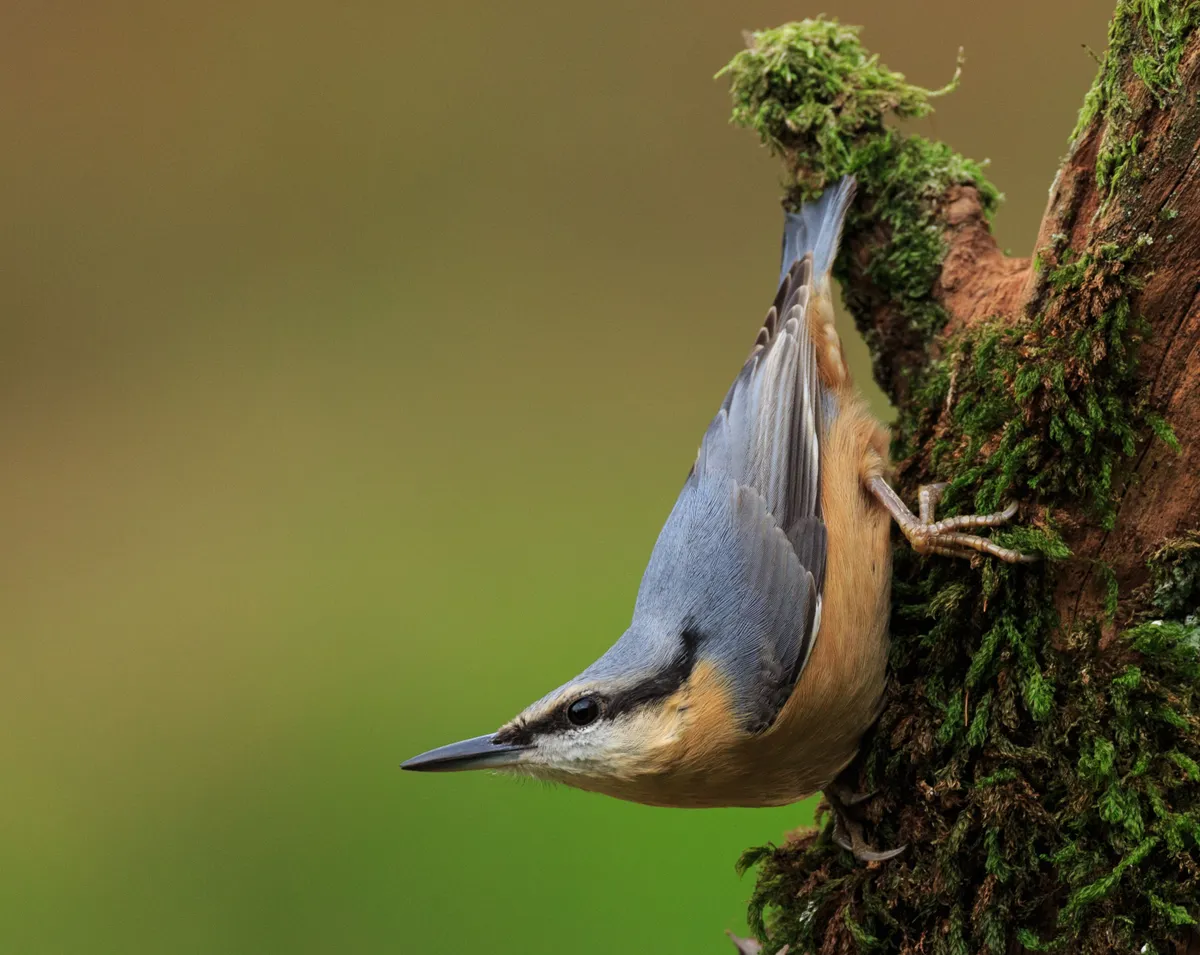
To identify a nuthatch look out for steel grey upper parts and a rusty buff colour below. Males are dark red-brown around the flanks and vent. Nuthatches are small, about the size of great tits but have a profile similar to that of a woodpecker.
The nuthatch is a bird full of character, a brash and often noisy interloper at garden feeding stations, whose unseemly behaviour has its origins in the need to find food.
During autumn and winter, nuts, seeds and invertebrates form an important part of the diet of nuthatches. At garden feeding stations, peanuts and sunflower hearts are particularly popular.
Greenfinch (Chloris chloris)
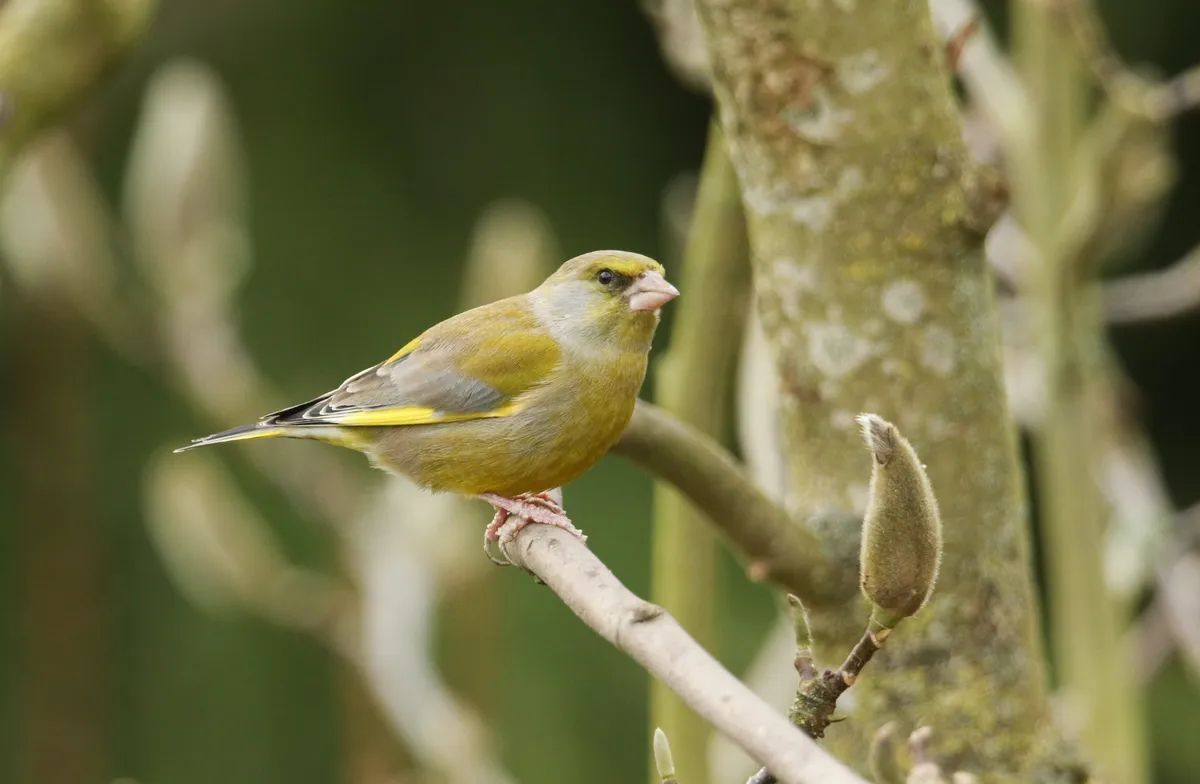
Greenfinches are about the size of house sparrows. Males are dull-olive green with greenish-yellow on the breast and rump, and have bright yellow wing flashes. Females are duller in appearance, with less yellow in their plumage. Juveniles are paler overall, and have streaked plumage.
Greenfinches rely on seeds and their large bills allow them to be able to eat a wide variety. They show some preference for seeds held within fleshy fruits, such as rosehips, though often ignore the fruit and just eat the seed.
During the autumn, seeds from yew and hawthorn are important, and in the winter, bramble. In gardens, they like sunflower seeds, whether they are black or hearts.
The greenfinch's scientific name, Chloris chloride, is a tautonym, where the genus and specific name are the same.
European goldfinch (Carduelis cardeulis)
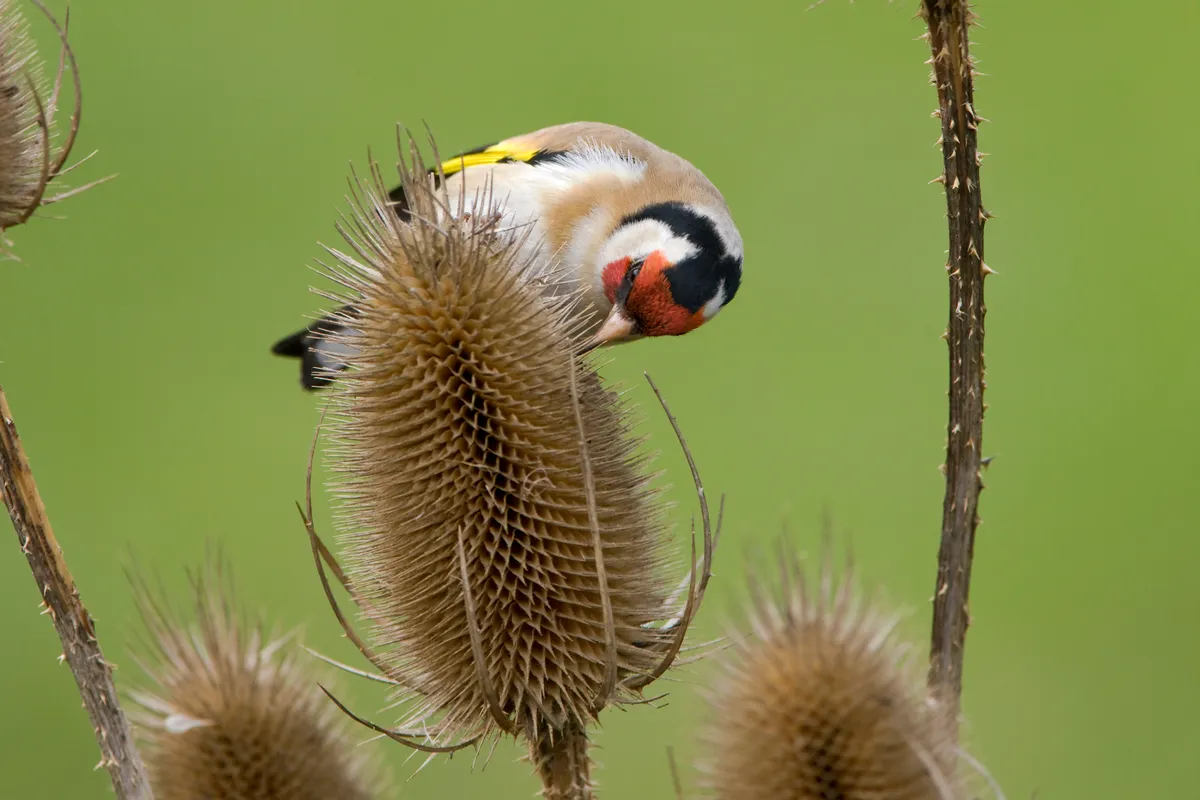
Adult goldfinches have red, clown-like faces with buff breast and shoulders. Their wings are mainly black, with white spots but are characterised by a broad, gold wing-bar on each wing.
Sexes look alike, although the red mask of the male, not the female, extends slightly past the eye towards the back of the head. Recently fledged birds do not have a red face, which moults through during late summer and autumn.
At garden feeding stations, goldfinches are particularly partial to small, oil-rich seeds, like nyger seed and sunflower hearts. These foods have become much more widespread in gardens over recent decades, attracting goldfinches in from the surrounding countryside.
Gardeners can also help goldfinches by fostering a number of plant species, mostly in the family Asteraceae, such as groundsels, which provide alternative ‘natural’ foods.
Teasels are another favourite – goldfinches are the only UK finch with a long enough beak to be able to extract its seeds.
The goldfinch's scientific name, Carduelis cardeulis, is a tautonym, where the genus and specific name are the same.
Common chaffinch (Fringilla coelebs)
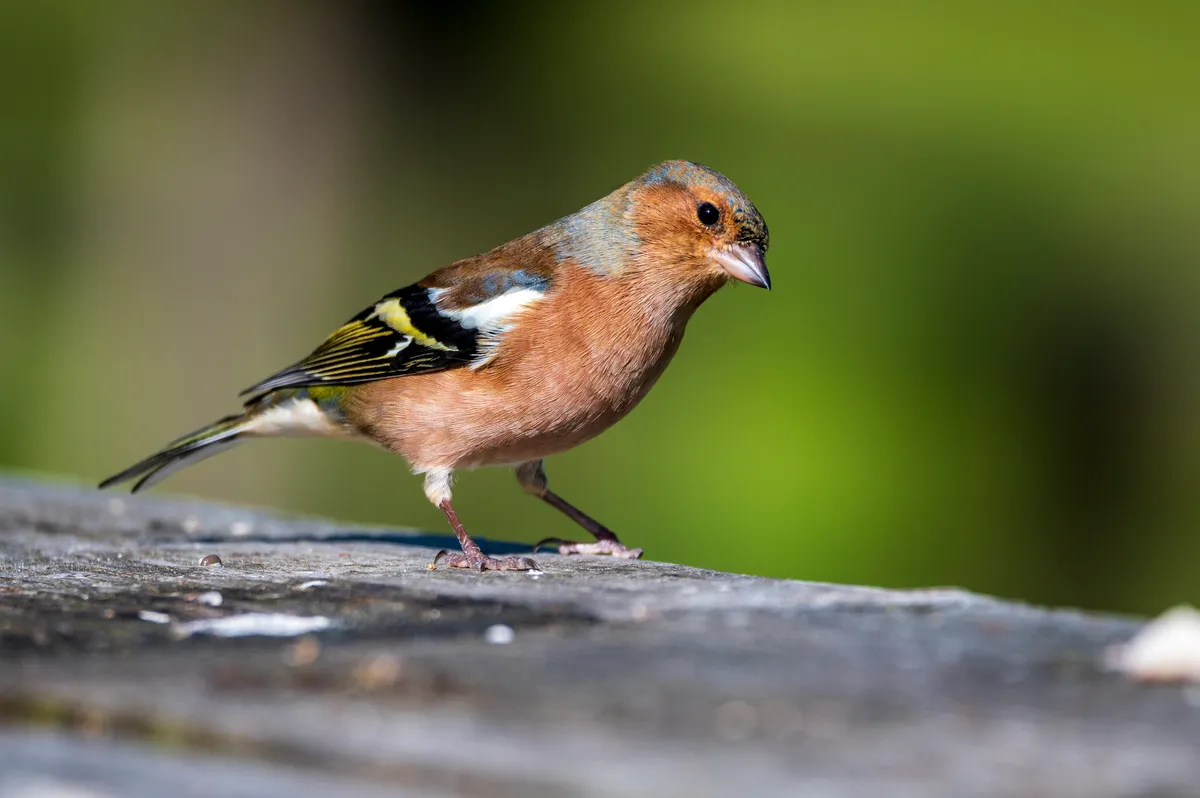
The male chaffinch (above) is unmistakeably handsome with a blue-grey cap, pink cheeks and breast and a reddish-brown mantle. Females and juveniles are much duller, consisting of grey-brown upper-parts and dull greyish-white underparts. All chaffinches, however, have distinct wing bars.
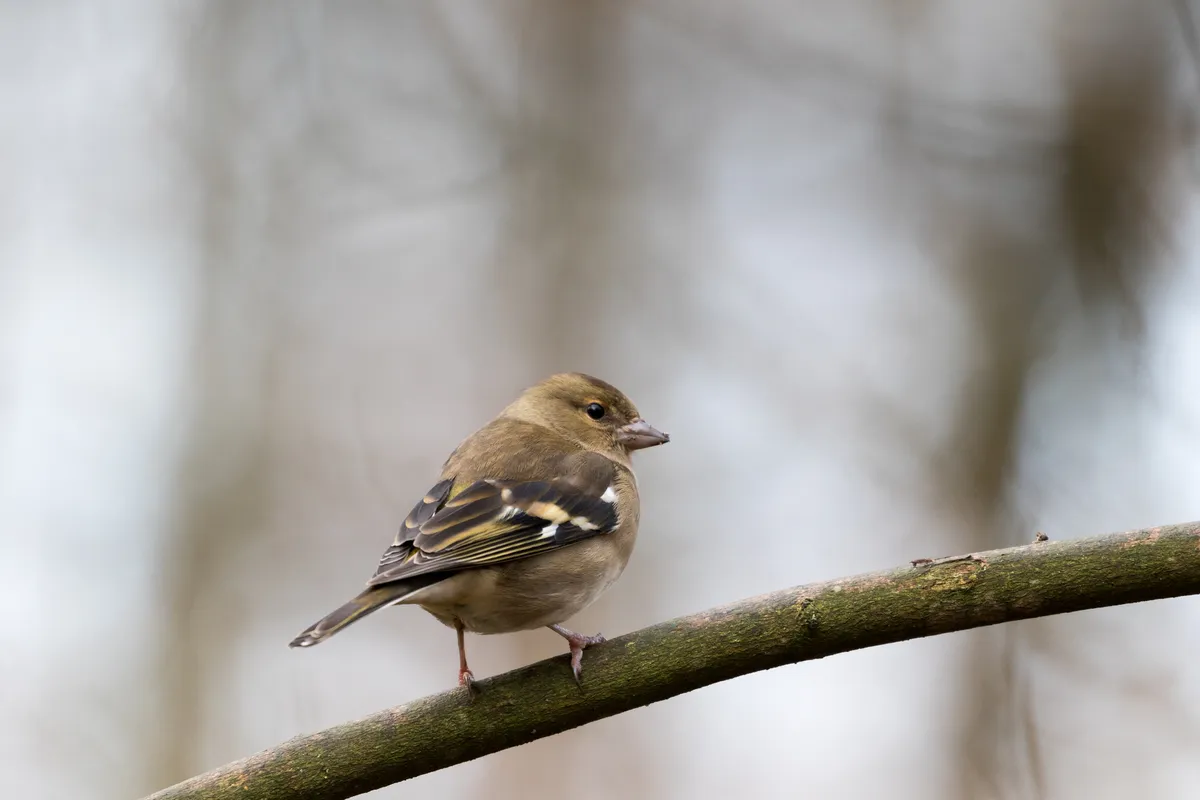
The chaffinch is one of the most common bird species in the UK and one of the top 10 most reported birds in Garden BirdWatch gardens. In Britain, the highest breeding densities are found in southern, central and eastern England, and on upland edges in northern England and Scotland.
Bullfinch (Pyrrhula pyrrhula)
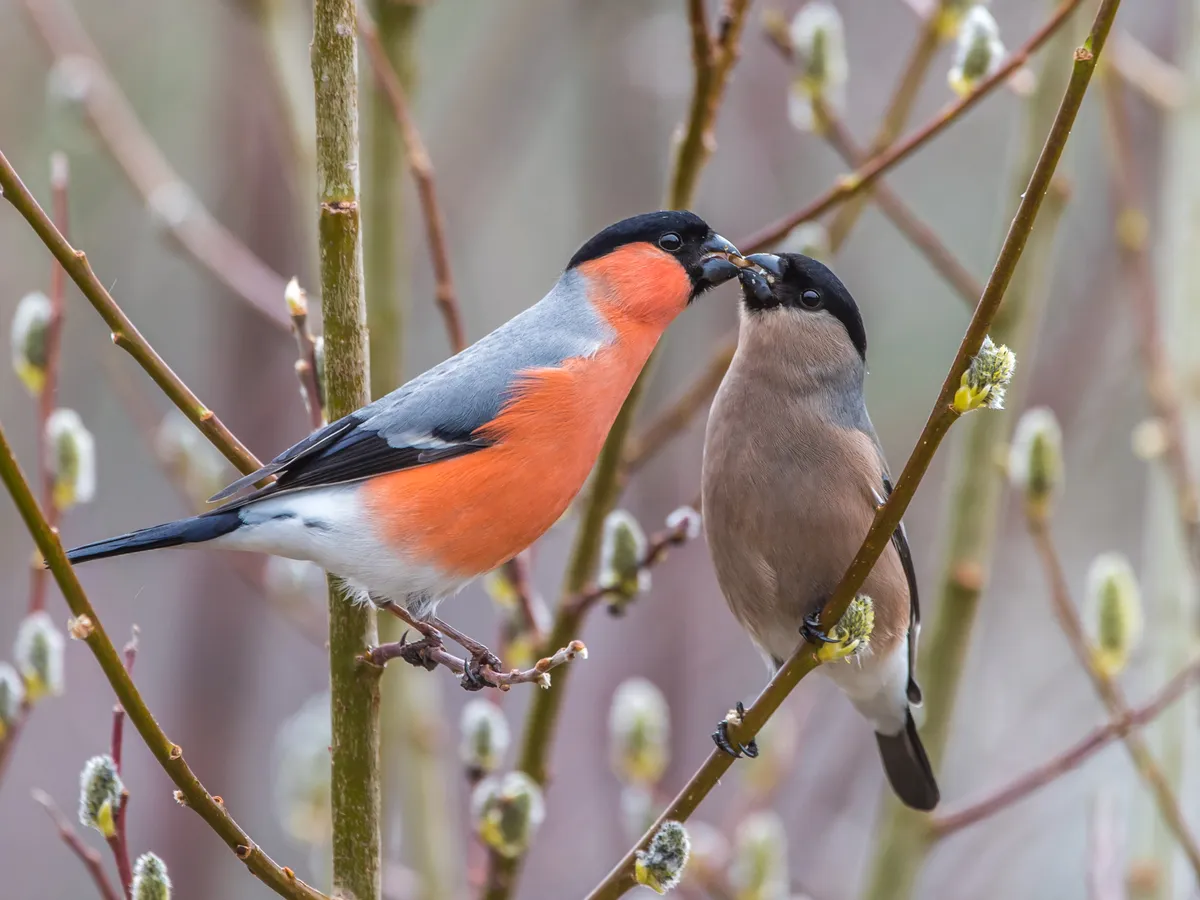
The bullfinch is a medium-sized finch that has quite a round body, with a large robust bill. Males and females have a black cap that extends forward around the bill, a grey back, black wings with a grey-white wing bar, a black tail and a white rump. However, while the female and juveniles are pinkish-grey, the male stands out with rose-red underparts.
You are much more likely to see a bullfinch than to hear one. They have a very soft and very subtle call which is a low, short whistle ‘peu’.
The male breeding song is very quiet as well, consisting of a descending series of notes, repeated at intervals. In addition, they are a skilful mimic and were popular cage birds at one point, with people determined to teach them different tunes that were played to them.
The bullfinch's scientific name, Pyrrhula pyrrhula, is a tautonym, where the genus and specific name are the same.
Eurasian sparrowhawk (Accipiter nisus)
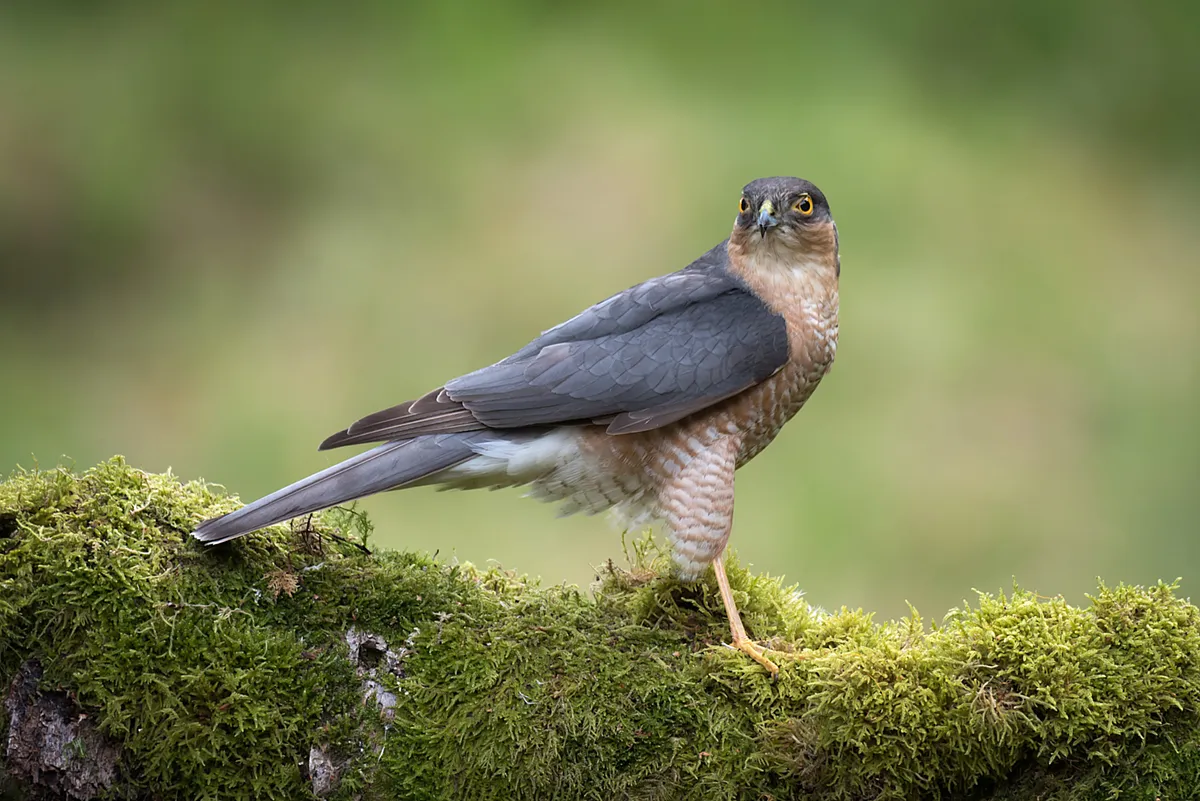
Sparrowhawks are small, broad-winged raptors with long tails and long, thin yellow legs. Adult males have slate-grey upperparts and fine rufous barring underneath. Females have brownish-grey upperparts and less rufous barring than the male. They have a more prominent white line above the eye.
While the sparrowhawk is now one of the most widespread birds of prey in Britain, until a few decades ago it was more or less extinct in many eastern counties. This was partly due to persecution, but also due to pesticide use in agriculture. As well as killing individuals, the accumulation of harmful compounds thinned their eggs, which increased breakages during incubation. This led to a population decline.
Sparrowhawks rely on the element of surprise and as such will often follow a regular route to get close to potential prey, which in gardens means using the cover of a hedge or shed. By moving feeding stations around your garden and keeping them close to cover, you can reduce the chance of a sparrowhawk attack.
Eurasian starling (Sturnus vulgaris)
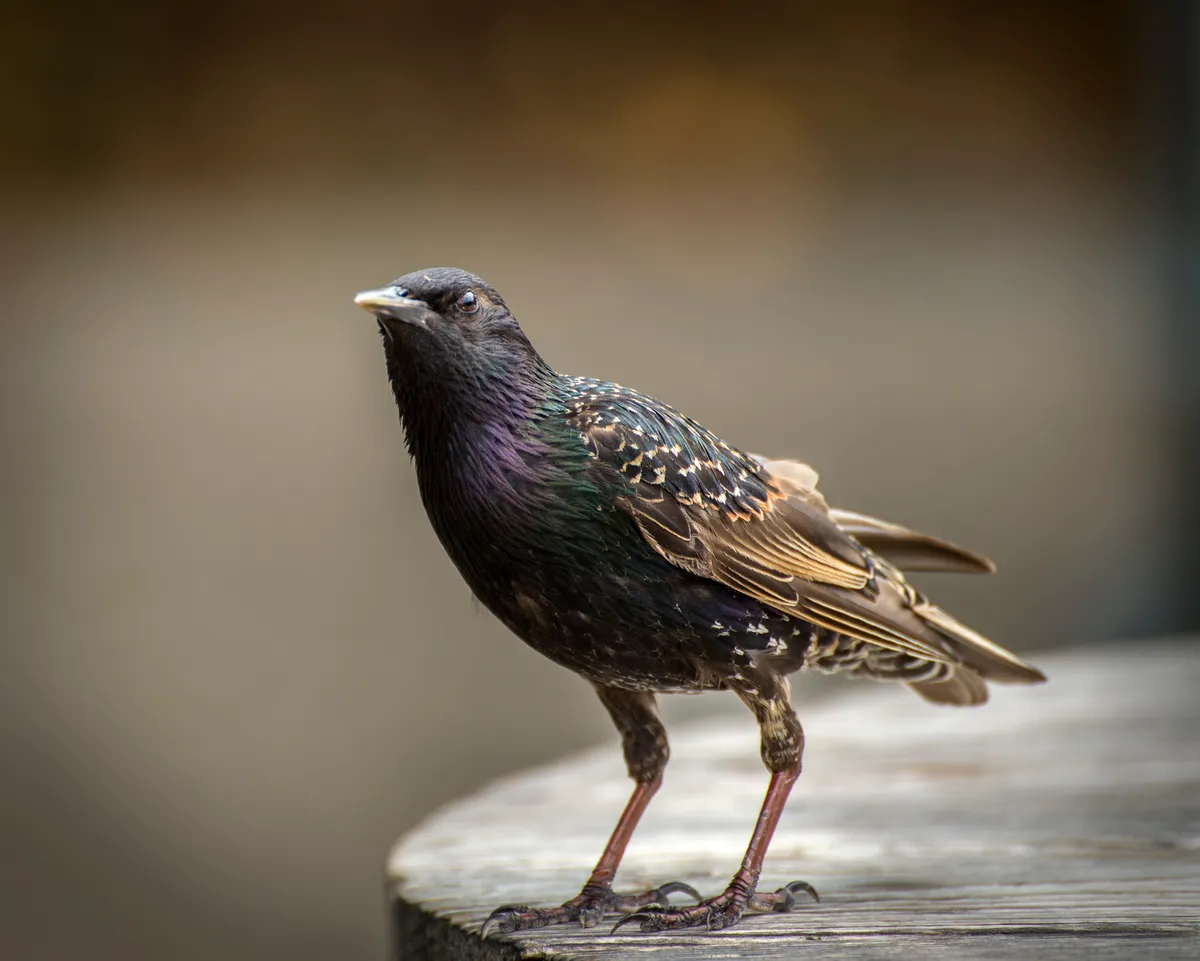
While starlings appear black at a distance, close up they have glossy green and purple iridescent plumage. In the breeding season, adults have yellow bills with different colour bases depending on their sex; in males this is blue and in females pink.
Quite a few garden birdwatchers complain about starlings because they seem to clean out a feeding station in minutes. Starlings do this as they evolved to feed quickly in flocks, rather than because they are greedy. It’s not their fault but it can get expensive so if this is a problem, try providing food, especially fat products, in feeders that exclude larger birds.
Great spotted woodpecker (Dendrocopos major)
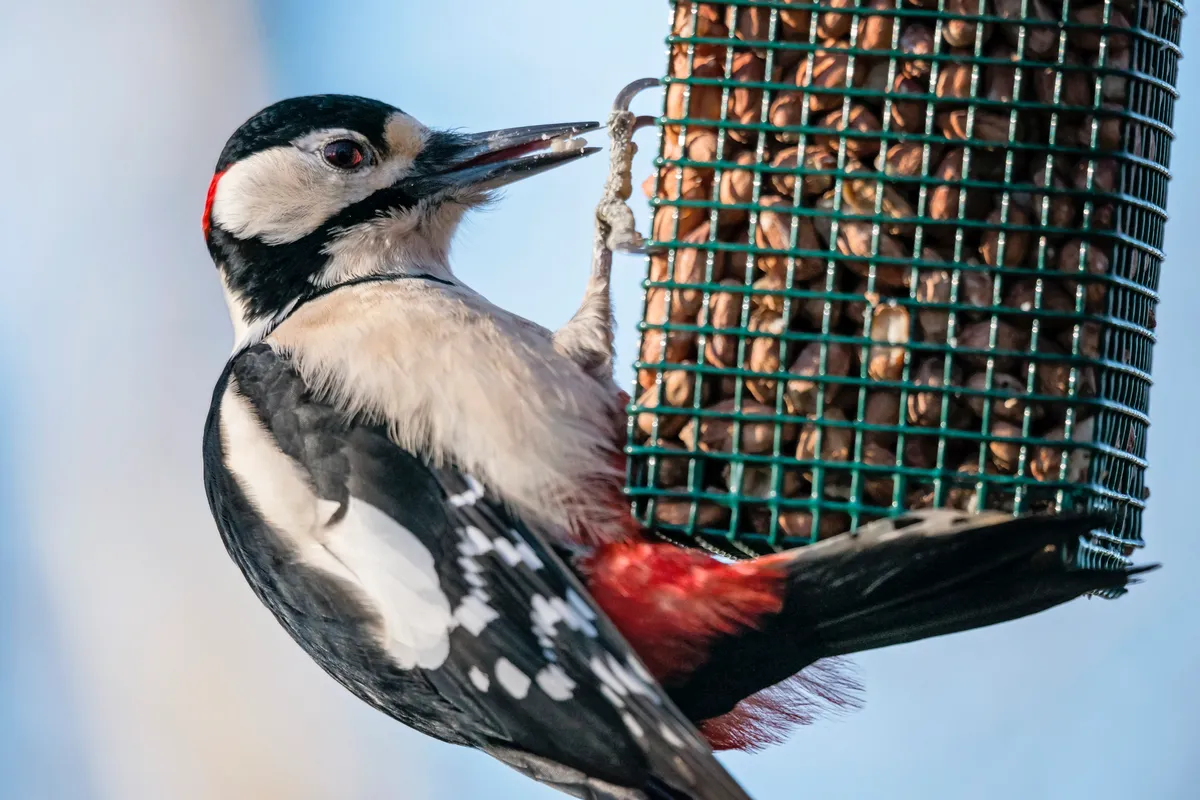
Identifying a great spotted woodpecker is relatively easy. There are just two black and white woodpeckers in Britain: the great spotted woodpecker and the lesser spotted woodpecker.
The former are about the size of starlings and are fairly widespread, while the latter are only about the size of greenfinches and are worryingly – and increasingly – scarce.
Great spotted woodpeckers take a wide variety of foods in gardens, happily hammering peanuts, chiselling suet-blocks or clearing trays of mealworms. As long as they can get a good grip on a feeder and can reach the food inside, they will sample most things.
Green woodpecker (Picus viridis)
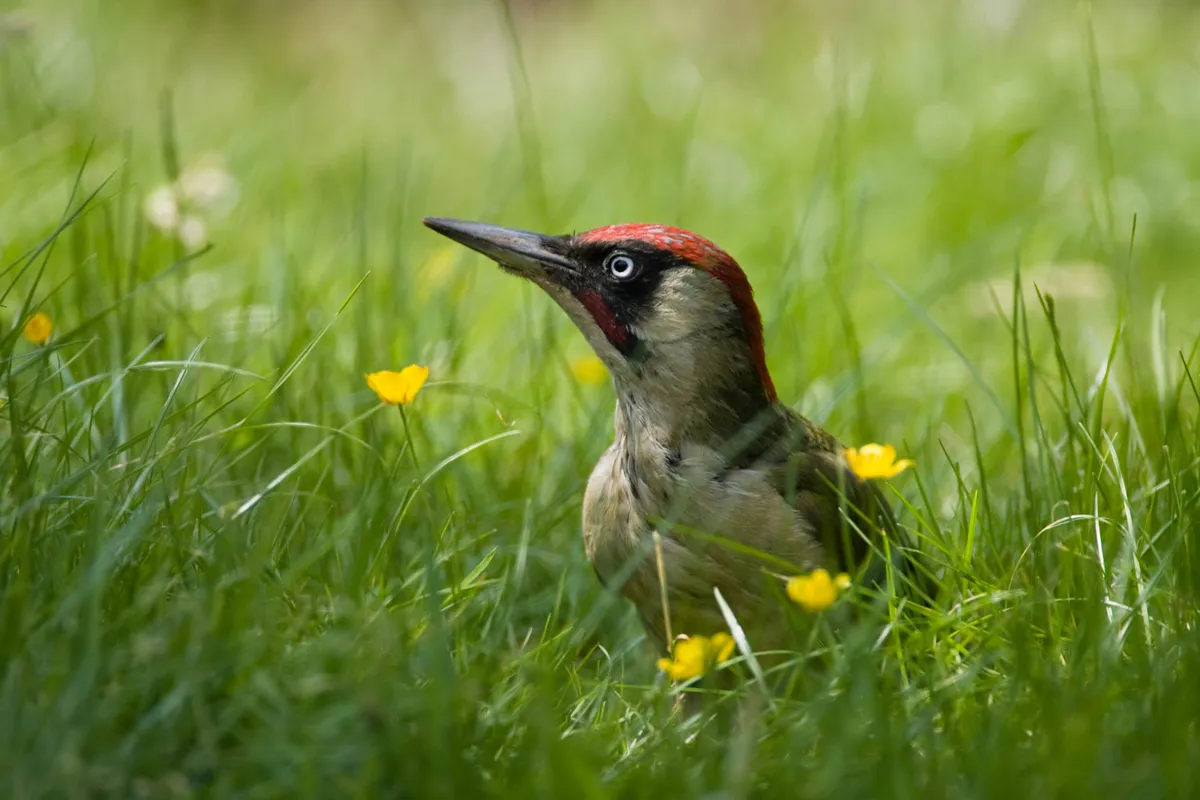
Male and female green woodpeckers look similar, but adult males will have a lot of red in the moustachial stripe, while there is none in that of an adult female. All ages and sexes have bright green plumage with yellow rumps and red caps, but in juvenile green woodpeckers, the plumage is streaked with grey.
If you are lucky enough to have green woodpeckers visiting your garden, then you will most likely have seen them on the lawn. This is because the green woodpecker diet consists mainly of ants – adults, larvae and eggs. They will eat other invertebrates, pine seeds and fruit, but usually only in the winter when ants become increasingly hard to find.
Green woodpeckers are very vocal and have a recognisable loud, laughing call known as a ‘yaffle’, which is often the only way you know a green woodpecker is nearby, as they tend to be quite wary birds. The yaffling is by far the most distinctive sound that green woodpeckers make, but you could also hear their song, which is a series of slightly accelerating ‘klü’ sounds.
Eurasian magpie (Pica pica)
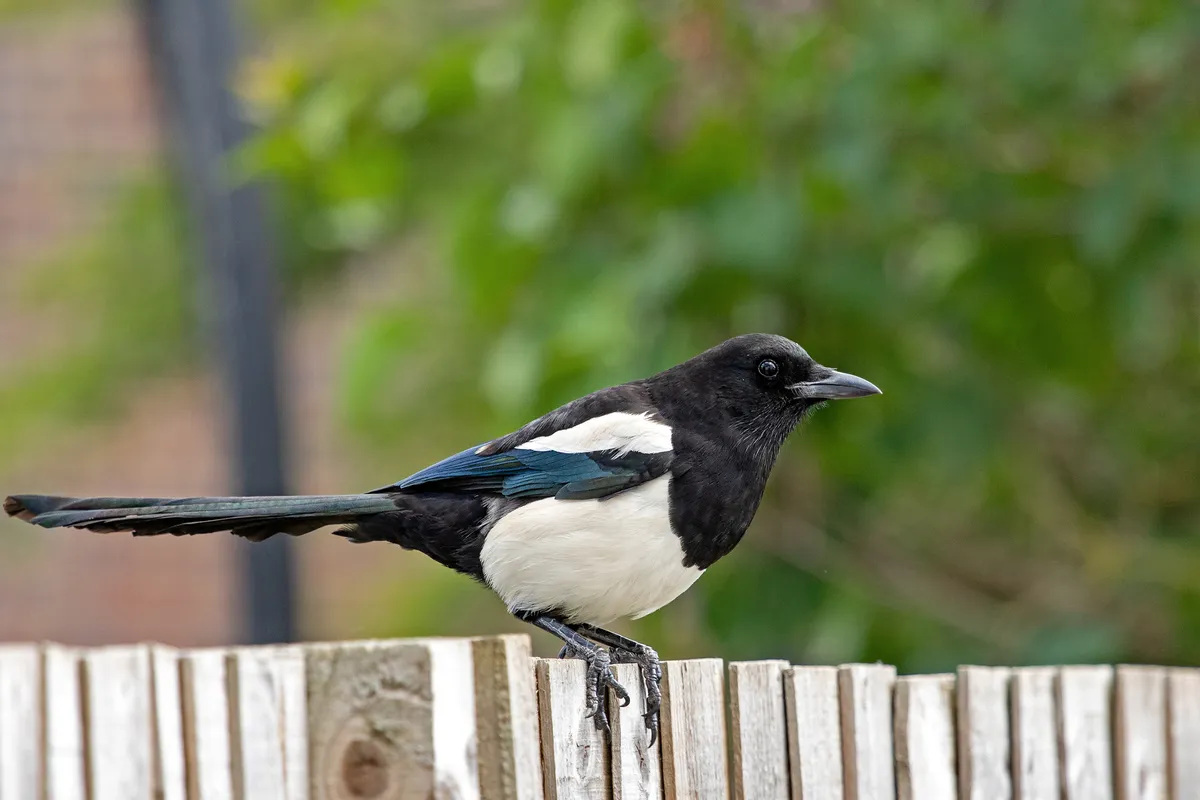
With its pied (black and white) body, blue wings and long tail, the magpie is a very distinctive bird and one of the easiest corvid species to identify.
The magpie's scientific name, Pica pica, is a tautonym, where the genus and specific name are the same.
Eurasian jay (Garrulus glandarius)
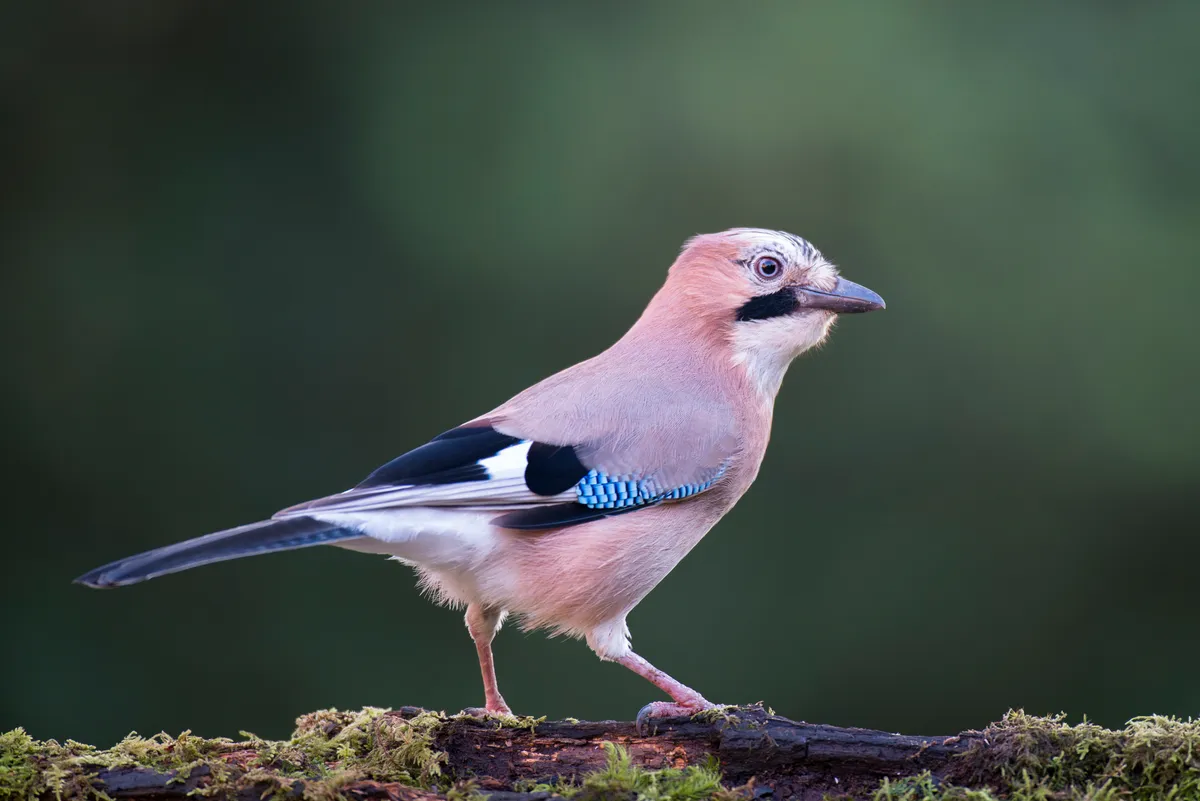
The jay a very colourful bird with a pinkish body, black and white wings with a patch of bright blue, a white rump, black tail, a pale streaked crown, black ‘moustache’ and pale chin. Despite their unmistakable, gaudy plumage, these colourful members of the corvid family are more often heard than seen. Their Welsh name, Ysgrech y Coed, means ‘shrieker of the woods.’.
Jays are well-known for caching food, particularly acorns, to eat at a later date – usually burying them in autumn, and retrieving them in winter.
Jays are skilful mimics of other birds and animals. When threatened, they are likely to imitate the calls of tawny owls, sparrowhawks and even domestic cats.
The British Trust for Ornithology (BTO) is a UK charity that focuses on understanding birds and, in particular, how and why bird populations are changing. Our vision is of a world where people are inspired by birds and informed by science.
Main image: Blue tit perched on the branch of a spring flowering crab apple tree © Jacky Parker Photography/Moment/Getty
